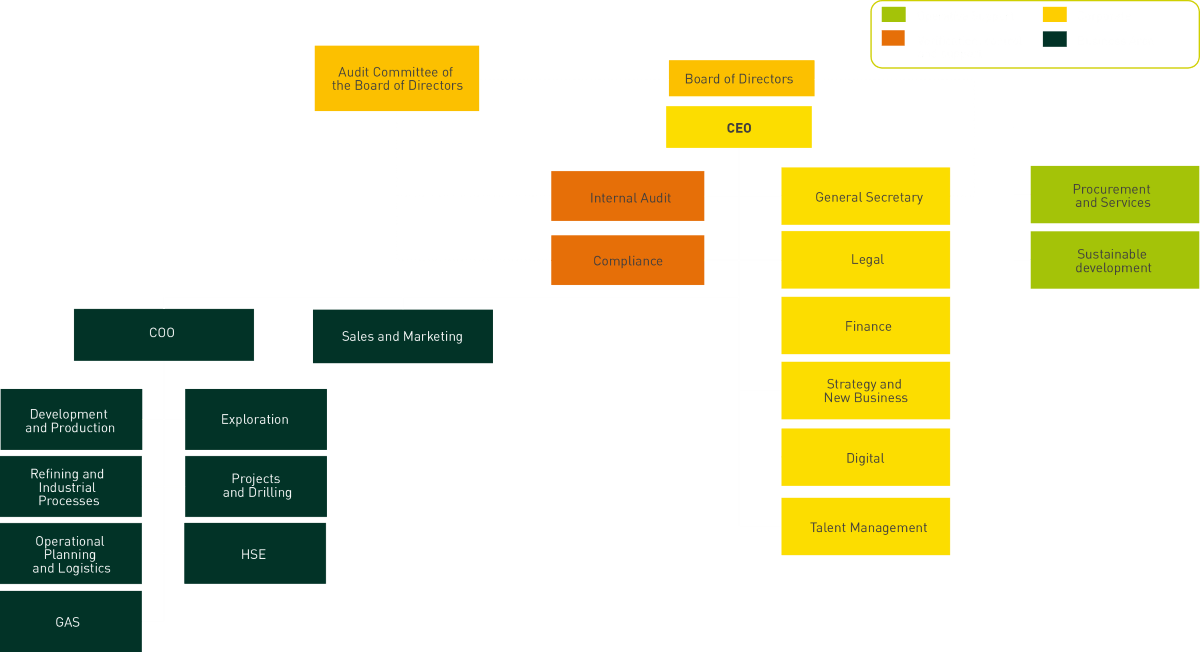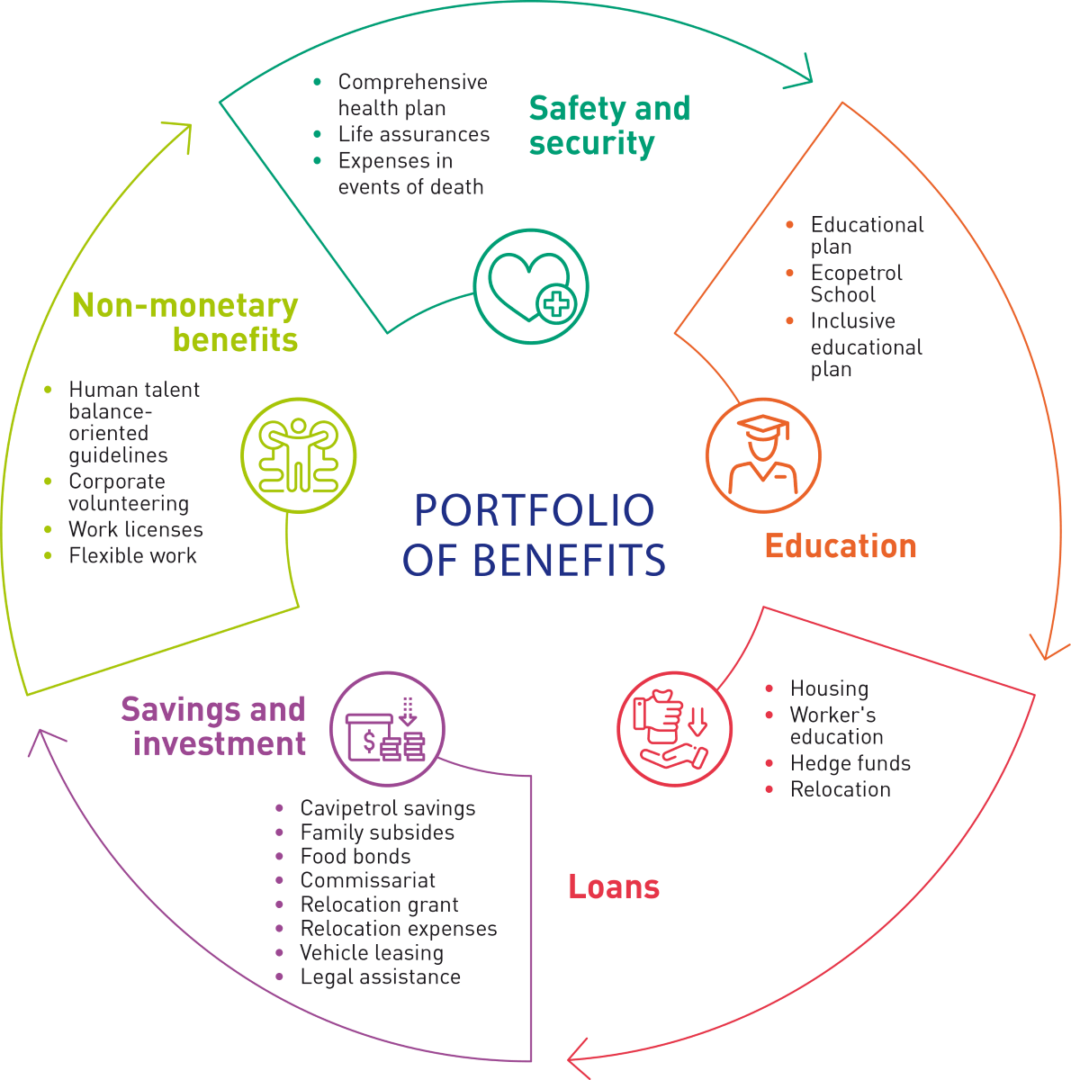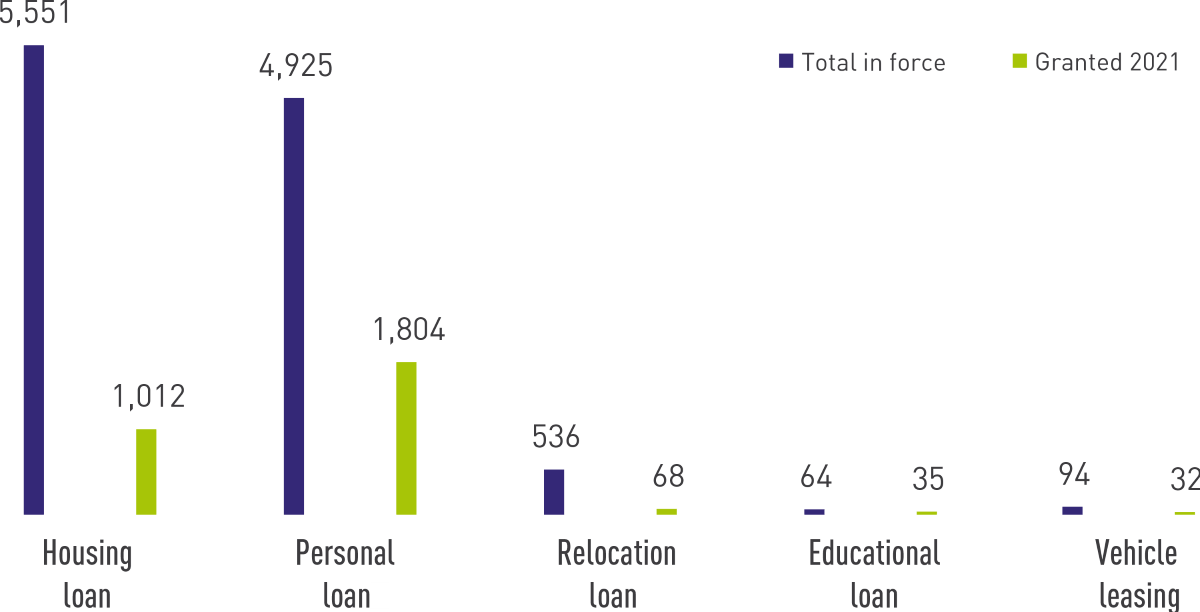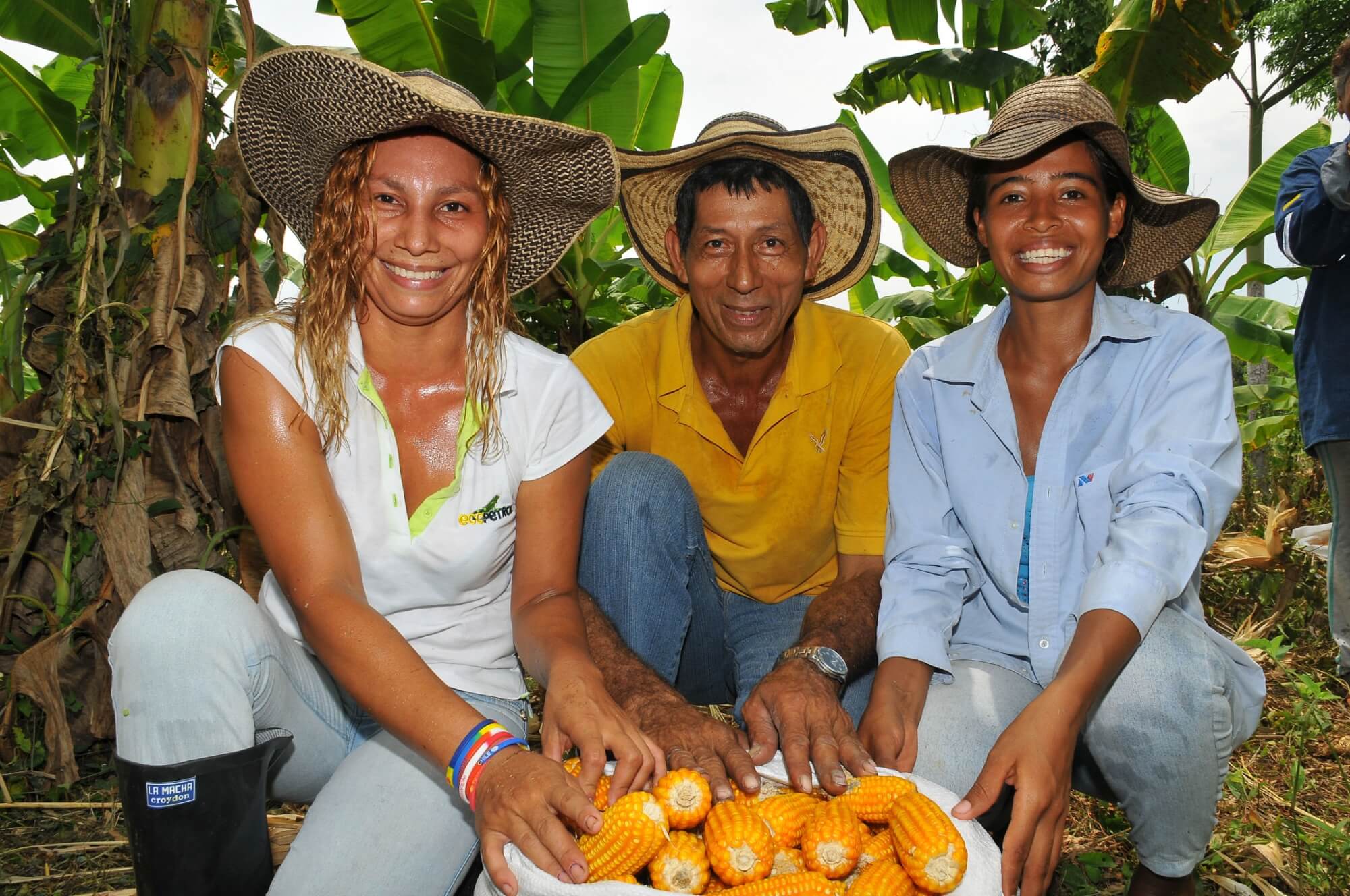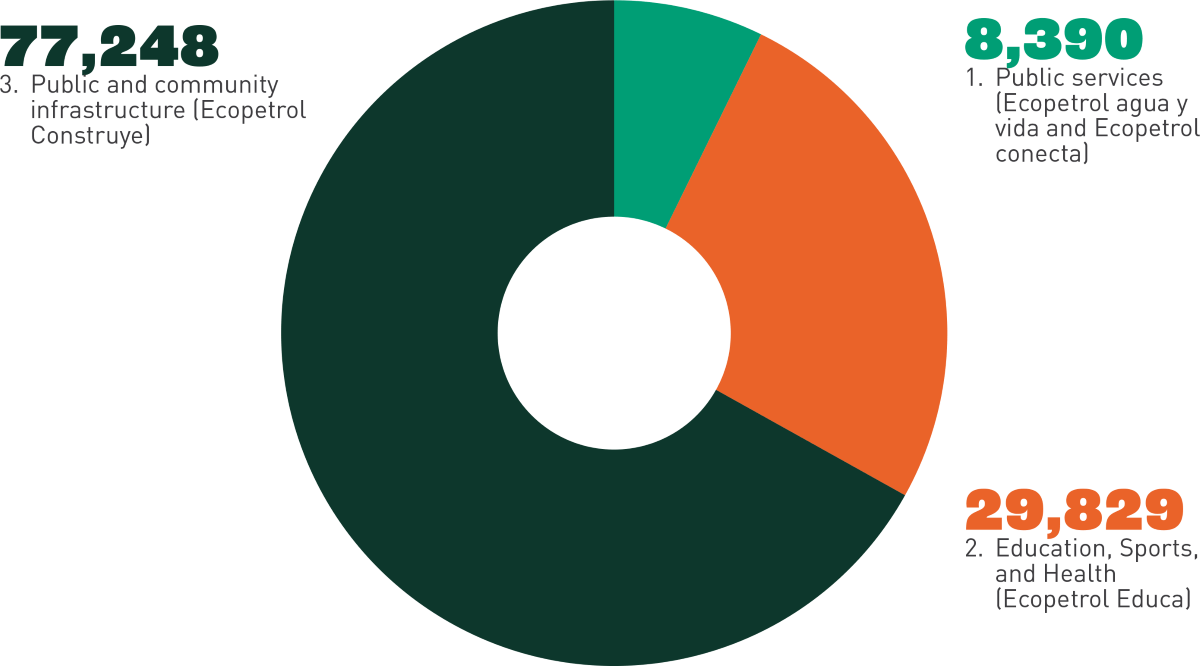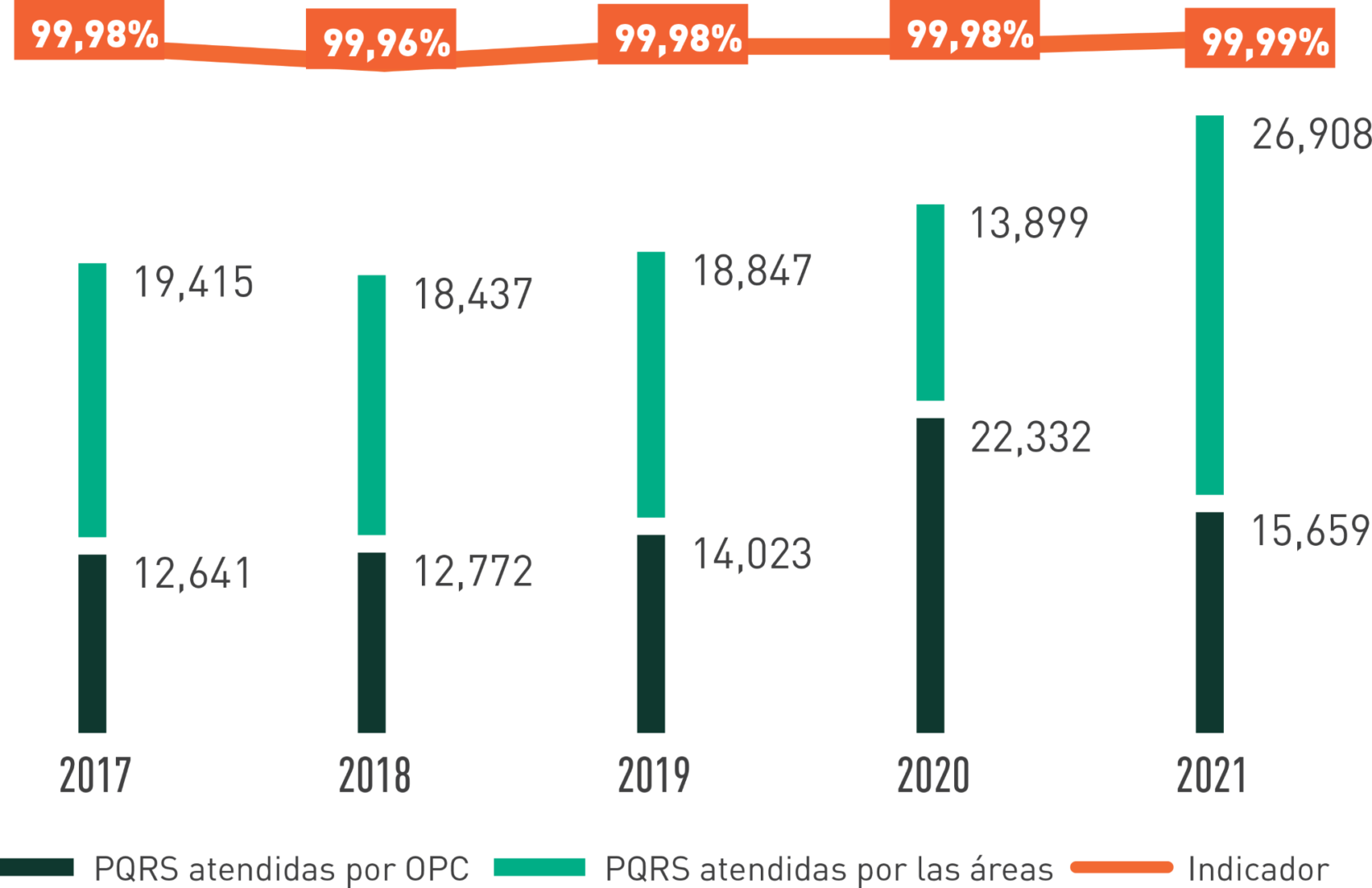Social

“Life First”
is the first principle of Ecopetrol’s Cultural Statement. This means that the fundamental premise of corporate management is to protect the well-being of workers, contractors, the community, partners, suppliers, investors, and the State. To achieve this, the Company follows its commitment to respect, promote, and exert Human Rights (HHRR) due diligence, which is in line with the responsibility that the Company has shown towards its most valuable asset: its people. The objective of being considered the company with the best social practices has steered its management efforts towards human talent and environmental matters. Being the leader in aspects related to health, employability, education, community strengthening, and participation mechanisms, among many others, is a priority for Ecopetrol.
Human Rights
Ecopetrol promotes a corporate culture of respect and promotion of Human Rights. During 2021, Ecopetrol’s management activities and objectives adhered to national and international standards and best practices. In this sense, it considered the results of the perception survey applied to Stakeholders, human rights risk analyses, self-diagnoses, contractor performance evaluations, the monitoring of risk prevention and mitigation plans, consolidated petition reports, complaints and claims, legal actions and Human Rights reports, and external evaluations, such as the Dow Jones Sustainability Index and the Corporate Human Rights Benchmark.

Commitment to respect
Human Rights
Ecopetrol updated its Guide on Human Rights and Business in 2021, an instrument approved by the Company’s CEO that defines the guidelines for the management of Human Rights within Ecopetrol Group.
This commitment extends to all those rights recognized internationally under the International Bill of Human Rights and the International Labor Organization (ILO) Declaration on Fundamental Principles and Rights at Work. The rights highlighted include: life, personal integrity,
The elimination of forced labor and the abolition of child labor, freedom of association and the right to collective bargaining, equality, and non-discrimination, as well as environmental rights, and others.
The HHRR guidelines are mandatory for all Company workers, senior executives, and suppliers in the development of their activities. They are also fostered among partners, associates, and other actors with whom Ecopetrol holds a contractual or commercial relationship.
Advancing Human Rights
Ecopetrol’s commitment to advance human rights is framed under six (6) principles set forth in the Human Rights Guide:
- Due diligence
- Transversality
- Complementarity
- Collaborative work
- Differential approach, and
- Monitoring and evaluation
Compliance with the Human Rights action plan
2019
90% goal
98% compliance
2020
90% goal
98% compliance
2021
90% goal
100% compliance
Human Rights Due diligence
(406-1) (WEF 20E)
Ecopetrol, within its human rights commitment, refrains from infringing the human rights of third parties and addresses the negative consequences on human rights in which they are involved (Guiding Principle 11).
For this, the Company has implemented a cycle to address human rights issues. As part of this management cycle, Ecopetrol identifies and manages the risks and negative impacts arising from its business activities, the supply chain, or other contractual or commercial relationships, and establishes corresponding prevention, mitigation, or remediation action plans. This is applicable at the strategic, process, and operational levels, in accordance with Ecopetrol’s Integrated Risk Management System.
To strengthen the due diligence process, Ecopetrol launched its Human Rights Risk Management Cycle Guide in 2021. This Guide defines key concepts and considerations for the planning, identification, evaluation, treatment, and monitoring of human rights risks, in accordance with national and international initiatives and standards. Similarly, the Company has Due Diligence Instructions to address complaints related to threats or situations that affect life and personal integrity, as well as a Declaration of Commitment to Respect Human Rights Defenders. These guidelines nurture the Company’s HHRR due diligence.
(406-1) (WEF 20E)
Women, children, Indigenous peoples, migrant workers, contractors, local communities, and victims of armed conflict have been populations especially regarded in the Company's due diligence process and for the Human Rights Risk Assessment.
Human Rights Evaluation
(411-1) (412-1) (WEF 22E)
Ecopetrol, within its HHRR due diligence framework, identified and evaluated possible human rights impacts and risks associated with its own activities, its supply chain, and other business relationships.
Human Rights Evaluation
| 2021 Human Rights Evaluation | Percentage of total operating sites where human rights risks have been assessed | Percentage of total operating sites where human rights risks have been identified | Percentage of operational sites with the presence of human rights risks where management actions have been adopted |
|---|---|---|---|
| Own operations | 100* | 100 | 100 |
| Tier 1 Contractors and Suppliers | 100** | 2.3*** | 100 |
| Joint Venture | 100* | 100 | 100 |
(406-1) (WEF 20E)
(409-1) (WEF 14) (WEF 22E)
After the Human Rights risk analysis, no situations involving the risk of forced labor were identified in the operations or in the supply chain.

Mitigation and remediation
(411-1) (412-1) (WEF 22E)
Dissemination, surveys,
and training
(409-1) (WEF 14) (WEF 22E)
97%
(9,062) of the workers received training in human rights policies or procedures
+ 7,450
workers were trained in Human Rights and the Business.
Human Rights commitments on Union
Agreements were fulfilled
Chapter XVII of the 2018-2022 Collective Bargaining Agreement (Union Agreement), under the title of “Human Rights and Peace,” steers the efforts conducted by Ecopetrol and the Oil Industry’s Trade Union (USO, by its Spanish acronym) to encourage respect, compliance, and the dissemination of human rights in the Company and in the regions where it operates.
In this chapter, the National Commission for Human Rights and Peace ECP – USO and different Human Rights Sub-commissions work towards the fulfillment of this purpose.
The National Commission is made up of two (2) representatives appointed by management to represent the Company, and four (4) workers appointed by the Union to represent the USO.
There are six (6) Subcommittees made up of one Ecopetrol representative and another Union representative for the entire Company, as follows: The Middle Magdalena, Cartagena, Neiva – Orito, Llanos, and Bogotá Sub-commissions. The National Commission for Human Rights and Peace ECP – USO, together with the Human Rights Sub-commissions, work towards the fulfillment of this purpose.
Activities undertaken in 2021
A female worker was kept following National Human Rights Commission, with the guarantees set forth in Art. 160 of the CCTV. This is a Union permission.
Nine (9) conventionally agreed meetings were held virtually, as well as five (5) in-person meetings, in compliance with the provisions established for the pandemic.
Four (4) meetings were held with Physical Security Management to address due diligence matters related to security and human rights in the regions prioritized according to the security situation.
Two (2) human rights biannual meetings were held, with the participation of the National Human Rights and Peace Commission and the Ecopetrol-USO Regional Human Rights Sub-commissions.
The National Diploma Course on Human Rights and Peace was imparted in collaboration with Universidad Nacional de Colombia, with the participation of 34 workers affiliated to the USO and other Trade Unions.
Various agendas were followed-through, and different solutions were devised for the effective protection of Human Rights with due diligence. This included the monitoring of workers relocated in the different areas of operation of the Company in previous years.
12 Human Rights Workshops, two (2) Regional Assemblies, and a National Workers for Peace Assembly were held.
Within the framework of the Union Agreement and under the principle of due diligence, the safety and protection requests submitted by workers and Union leaders were addressed in a timely and effective manner, guaranteeing the fulfillment and effective exercise of their rights under the constitutional and legal framework.
Indigenous communities
(OG-9) (OG-10) (WEF 21E)
Ecopetrol has a differentiated corporate approach to engaging with Indigenous peoples.
(OG-9) (OG-10) (OG-12) (WEF 21E)
The relationship approach includes, among others:
The identification of the affected Indigenous peoples before acquiring a new Block or expanding the areas of operation. This implies confirming the presence of ethnic communities, their geographic location, and identifying the potential environmental, cultural, and social implications of the project.
Understanding the local context to establish relationships with Indigenous peoples: the objective of this characterization is to have an understanding of the community as a local social and political actor, in order to identify their expectations.
Identifying the principles of good participation of Indigenous peoples, using the Guide on relations with ethnic communities, Guidelines for dialogue with ethnic communities, and Guidelines on coexistence with ethnic communities.
Free, prior, and informed consent.
Commitment to protect and preserve cultural heritage from the adverse impacts of local activities.
Grievance mechanisms.
Relocation/resettlement audit and evaluation.
To establish relationships with ethnic groups living in the areas of operation, Ecopetrol adopts the process of intercultural dialogue as a principle and articulating pillar for its actions.
This is why, in addition to the diagnoses of the territories to identify relevant information on the characteristics of ethnic groups, baselines are built with intercultural and participatory methodologies to collect information from the community during the prior consultation processes, covering social, cultural, environmental, and cartographic aspects to understand the context of the community and, subsequently, to establish measures to manage the impacts of the project. In 2021, two baselines were defined for production projects with the Pasto-Orito-Siberia and Camentsa Biya Communities in the municipality of Orito, Putumayo.
However, there is no database showing the location of communities whose land has not been legally constituted, since the National Government must legalize the definition of territorial limits.
Ecopetrol’s intercultural
conflict prevention and
management plan
The Relationship guide with ethnic communities establishes that:
1
All Ecopetrol workers must read the Guide and expressly state that they are willing to comply with it.
2
The Guide must be included as an annex to the contracts when field work is to be conducted in territories with the presence of ethnic communities.
3
Community leaders must be informed about the mechanisms available for handling suggestions, doubts, and concerns about the company’s activities.
4
The workers and contractors of the project or operation must inform their respective supervisors or leaders of any conflict arising between them and the communities. Ecopetrol is open to establishing intercultural dialogue to resolve any differences with the communities.
(411-1) (WEF 22E)
No violations of the Human Rights of Indigenous peoples were recorded in 2021,
nor was there any resettlement of ethnic communities.
Prior consultation
(OG-10) (WEF 21E)
Throughout 2021, Ecopetrol’s relationship with ethnic groups in its areas of influence was based on intercultural dialogue in order to maintain trust connections. Similarly, the Company reactivated the prior consultation process that had been underway in 2019 and suspended in 2020 due to the pandemic. Two(2) processes were ensured for the identification of ethnic groups in the areas of operation of the Company.
First, to guarantee the right to prior consultation for each project in Colombia, once its general operational scope and its areas of influence and intervention are defined, the Company files the formal procedure with the National Authority Administration for Prior Consultation – (DANCP, for its Spanish acronym), part of the Ministry of the Interior of Colombia, to determine whether or not to conduct the prior consultation. The supporting documentation provided by Ecopetrol for the process is part of a technical summary that includes:
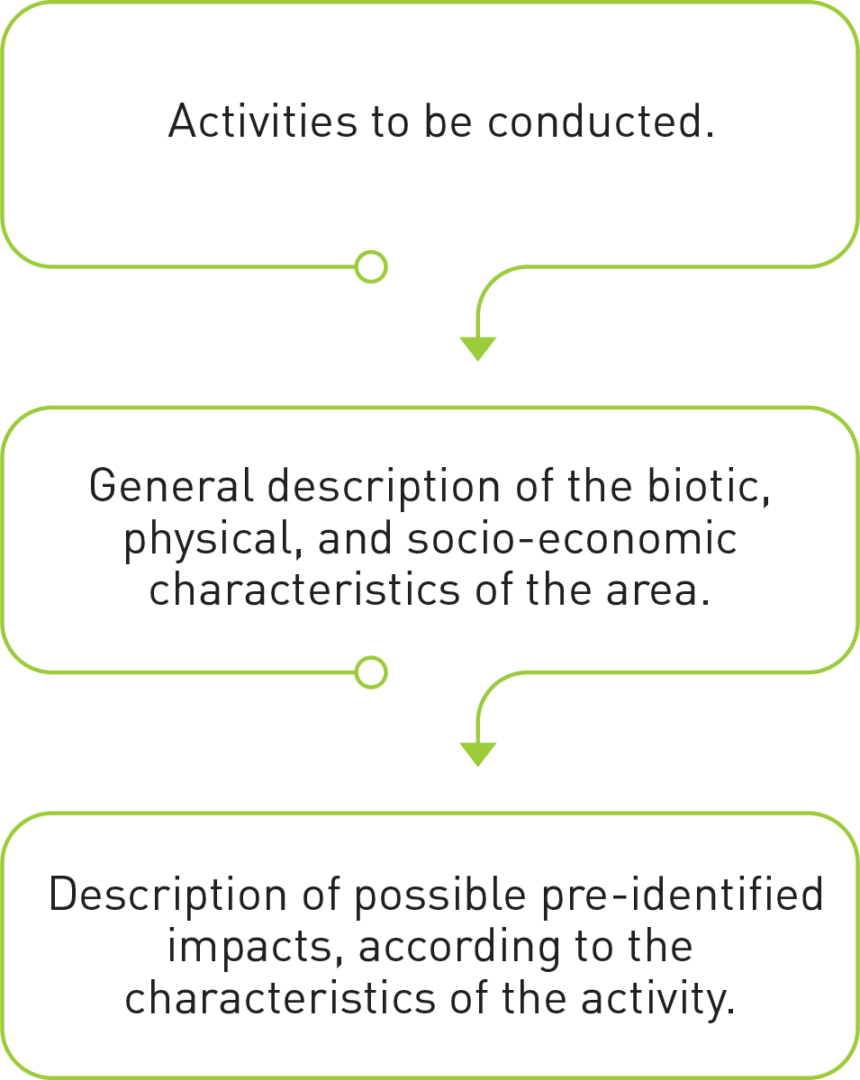
In the areas where there is already information about the presence of ethnic communities, Ecopetrol informs the authority about the possible impacts of the project to the previously identified communities.
Second, in Colombia, once the DANCP analyzes the information, it issues a resolution that determines whether or not prior consultation is appropriate for the project. In positive cases, prior to the start of the project, Ecopetrol requests said entity to initiate the coordination of the consultation process.
During some phases of the project, ethnic groups not reported by the DANCP may be identified in the areas. In such a case, as part of the human rights due diligence process, Ecopetrol verifies the situation and reports it to the DANCP, confirming the presence of said community in the area, and requests the due pronouncement of the Authority regarding the applicability of the prior consultation. In 2021, there was no evidence of unidentified communities in the project areas.
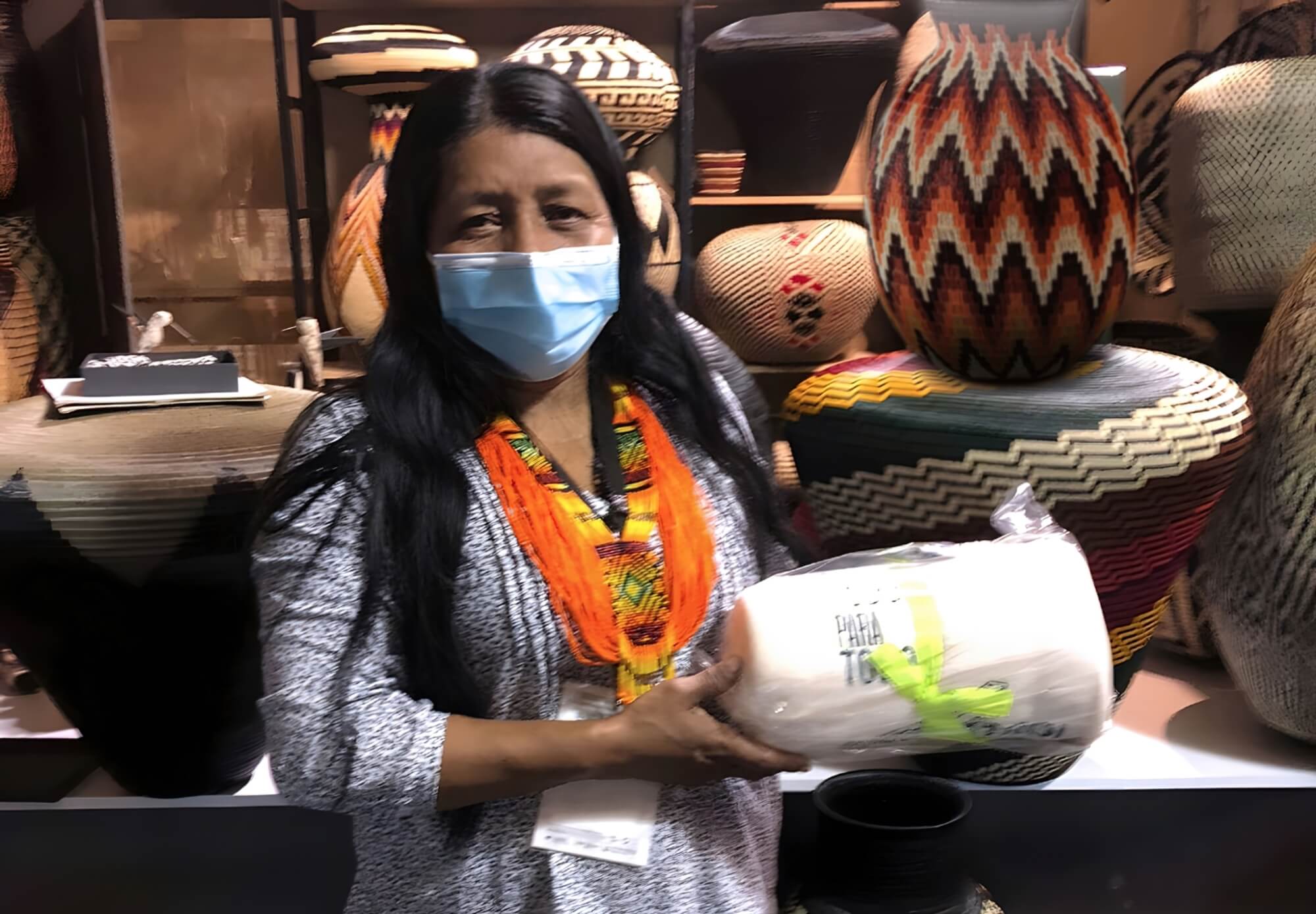
Relevant information on the
previous consultations conducted
and under monitoring
In 2021, the Company took the following steps to define whether or not the prior consultation process was applicable for its projects:
Determination of applicability of the prior consultation process by the DANCP for
seven (7) projects
nine (9)
prior consultation
processes were conducted for two (2) Production Field development projects.
four (4)
prior consultation processes
were closed for three (3) exploratory projects, two (2) due to compliance with agreements and two (2) due to project withdrawal.
As part of the relationship strategy with the DANCP,
two (2)
technical workgroups
and a training session were held, with the participation of employees from the entity.
In Colombia, free, prior, and informed consent is necessary for the implementation of projects involving any of the situations below specified by the Constitutional Court:
(i)
Transfer or relocation of Indigenous or tribal communities from their place of settlement.
(ii)
Storage or deposit of hazardous or toxic materials in their territories.
(iii)
Measures implying high social, cultural, and environmental impact on their subsistence.
Relationship with
ethnic communities
Intercultural Dialogue with the Unuma Meta Indigenous Reservation
After the reversal of the Rubiales Field to Ecopetrol, a consultation for reparation was conducted by Court order with this reservation. Since the consultative process, dialogues have been maintained with the reservation in two (2) aspects:
1
First, the establishment of a Relationship Guide to serve as a Roadmap for dialogue, conflict resolution, and the planning of future actions;
2
Second, both parties worked together during 2021 on the formulation of “trust-building” projects, which has prioritized the projects that seek to improve the living conditions of the community.
Agreement to sponsor
ethnic group artisans
in EXPOARTESANIAS
Expoartesanías is the most important craft fair in Colombia, with the participation of local artisans from all over the country. In 2021, Ecopetrol enabled the participation of
124
artisans
from different ethnic groups from
17
departments.
The participation of these artisans in the fair is an important contribution to their economy, and it also strengthens the cultural practices and the ancestral knowledge applied when elaborating these masterpieces.
Archaeological authorizations
Activities were undertaken as part of
41
ppreventive archeology programs
implemented in
four (4)
of Ecopetrol’s regions,
mainly in Orinoquía and Middle -Central- Magdalena, which gather the largest number of these types of activities. Within these programs,
10
new preventive archeology programs
initiated in operational and exploration areas, pursuant to Decree 138 of 2019, in order to standardize the Company’s archaeological processes and the correct monitoring of all these activities.

Resettlements
Ecopetrol’s population resettlement procedure is based on the United Nations Guiding Principles on Business and Human Rights and International Policies on Population Resettlement, which establish the conceptual and methodological route to prevent, mitigate, correct, and offset the economic and social impacts caused by the involuntary displacement of the population as a result of the Company’s operations and projects. The procedure also defines actions to restore socioeconomic conditions and generate opportunities to improve the conditions of the population to be resettled.
In 2021, there were
1,785
resettlements
ases on involuntarily displaced families in the Central Region. The table below shows the Company’s assets and projects that required such resettlements:
2021 resettlements cases
| Asset / Project | Type of Resettlement | |||
|---|---|---|---|---|
| Temporary | Permanent | Status | Total | |
| Casabe Field Well 929 | 3 | 0 | Closed | 3 |
| Casabe Field Well 967 | 4 | 0 | Closed | 4 |
| Casabe module III Cluster 9 | 0 | 1 | Follow-up | 1 |
| La Cira – Infantas Field | 1,720 | 45 | Follow-up | 1,765 |
| Nafta Project | 6 | 6 | Follow-up | 12 |
| Totales | 1,733 | 52 | 1,785 | |

Security and
Human Rights
Ecopetrol has explicitly stated its commitment to the Voluntary Principles on Security and Human Rights by adopting an approach that advances and respects HHRR.
This approach includes the following elements:
1
Risk evaluation:
the identification methodology compiles a specific risk associated with the violation of Human Rights, known as “GDE3.4 Violation of Human Rights, by the public force or private security companies in the planning, sustainability, and closure of local activities or commitments.”
2
Interactions with public security:
Ecopetrol enters into collaboration agreements with the Public Force, incorporating the Human Rights clause and emphasizing respect for said rights in legal and conventional terms.
3
Interactions with private security:
Ecopetrol enters into contracts with private security companies, which contain a common clause based on the Voluntary Principles on Security and Human Rights related to private security.
4
Supervision of security providers to ensure that they comply with their obligation to provide security in a manner consistent with the rules of conduct established by Ecopetrol:
The Company exerts risk control to monitor security providers in order to guarantee that they meet their obligation to provide security in accordance with the standards of conduct described by the Company. In addition, a specialized team reviews and issues a report with the findings and areas for improvement.
5
Grievance mechanisms that protect the security forces:
The citizen participation office (OPC, by its Spanish acronym) at Ecopetrol is responsible for receiving PQRs (petitions, claims, and complaints) related to Ecopetrol’s presence in the different regions in the country. PQRs allow the Company to address citizen concerns directly and this feeds into the monitoring efforts to improve internal processes.
6
Audit and evaluation of security contractors:
Within the various contractual clauses, Ecopetrol contemplates mechanisms to control and measure performance in all activities under the contract,including Human Rights. Procuring private security services is a process that entails the selection of different bids (not contracted directly).
Ecopetrol establishes training requirements for all direct workers and organizations providing security staff. Below is a chart of security personnel who have received formal training in specific Human Rights policies or procedures:
Total number of security employees trained on Human Rights
2,947
Total number of security workers
1,424
Number of security workers who have received formal training in specific Human Rights policies or procedures
48.32%
Percentage of security personnel who have received formal training in specific Human Rights policies or procedures.
Promoting Human
Rights in the supply chain
Ecopetrol’s internal labor regulations establish the labor standards to be met by all suppliers when undertaking activities for the Company. By means of this policy, the commitment to respect all human rights is explicitly stated, with special emphasis on the supply chain:
Decent, favorable, and adequate working conditions.
Freedom of association and collective bargaining.
Equality in employment and occupation.
The abolition of any form of child labor.
Similarly, as part of Ecopetrol’s Human Rights Training Program, the Company led the
2nd Co-Creation Workshop on Human Rights in the Supply Chain
in September 2021, with the participation of the Office of the United Nations High Commissioner for Human Rights in Colombia, the ILO, and the OECD.
More than 70 key suppliers participated in this workshop, which allowed the Company to reinforce the practical implementation of international human rights standards. Ecopetrol’s suppliers demonstrate their commitment to advance and respect Human Rights through the implementation and dissemination of policies and good practices.
Significant investment agreements
and contracts containing human rights
clauses or submitted to Human Rights evaluation
(412-3)
At Ecopetrol, two (2) determinants are considered to define significant investment agreements and contracts containing human rights clauses:
(i)
Agreements or cooperation agreements deriving from or managed by the Vice Presidency of Sustainable Development, entered into for protecting the critical infrastructure of the Company, in addition to being representative in risks associated with human rights and security.
(ii)
Service contracts entered into as of 2016 and in force as of December 31, 2021, managed by the Vice Presidency of Supply (goods and services) and subject to the Human Rights and Corporate Social Responsibility annex.
At Ecopetrol,
99.57%
of significant agreements and contracts
contain human rights clauses and are subject to the corresponding evaluations. As of December 31, 2021, there were
3,989
valid service contracts,
of which 3,972 were signed after the entry into force of the Annex on HumanRights and Social Responsibility in October 2016. The remaining 17 contracts were signed before the aforementioned date, which is why the are not subject to the Annex.
Investment agreements and contracts containing human rights clauses
Total number of significant investment agreements and contracts
Number of significant investment agreements and contracts containing human rights clauses or submitted to human rights evaluation
Percentage of significant investment agreements and contracts containing human rights clauses or submitted to human rights evaluation
Also,
100%
de of the security contracts
entered into by Ecopetrol contain a specific clause on the Voluntary Principles on Security and Human Rights.
Human talent
Organizational
structure
These are the main changes made to the organizational structure in 2021:
- Operational Planning Office is now the General Operational Planning and Logistics Office: thereby comprehensively addressing the processes of the crude oil and products supply chain in all segments, both of the Company and of the Group, as well as the processes related to integral logistics and transport services.
- Elimination of the Vice Presidency of Operations and Transportation Logistics: to achieve synergies and greater efficiencies in the organizational structure, the duties of this Vice Presidency were transferred to other areas of Ecopetrol.
- Elimination of the Vice Presidency of Transportation Operations and Maintenance: As part of the midstream transformation, and in order to generate greater value, profitability, and sustainability for Ecopetrol Group, Cenit fully took over the local operation of the hydrocarbon pipeline transportation system in the country, thus eliminating the aforementioned Vice Presidency.
- The Innovation and Technology Center (ICP) became dependent on the Digital Vice Presidency, centralizing the Science, Technology, and Innovation strategy.
Compensation
& Benefits
Ecopetrol’s Compensation Policy ensures conditions that encourage employees to invest their maximum commitment and potential in the Company, thereby attracting, creating loyalty, and retaining the human talent required for the development of the corporate strategy.
The main components of the Total Compensation at Ecopetrol are
fixed compensation, benefits, and variable compensation.
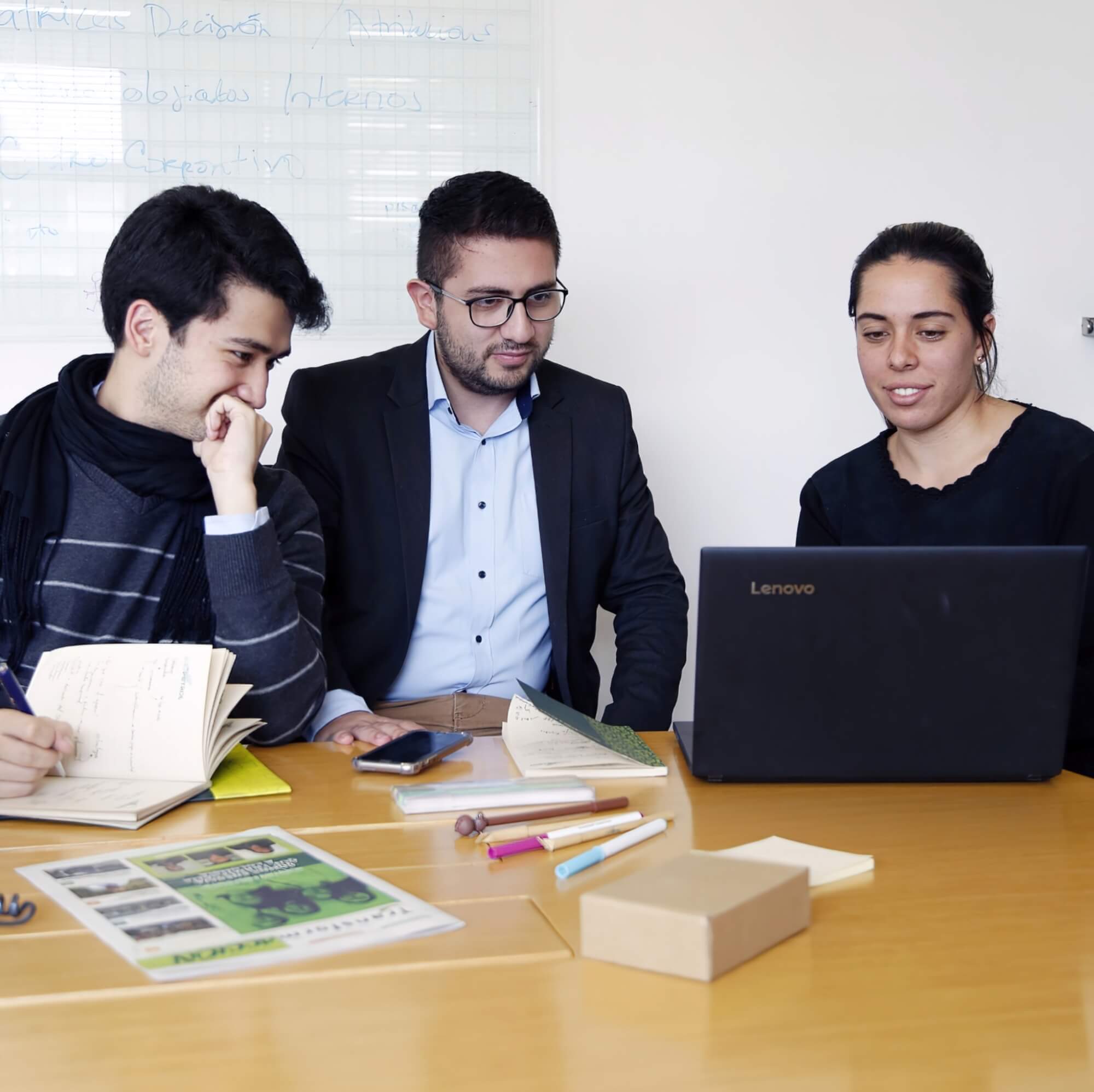
Fixed Compensation
Fixed compensation corresponds to all guaranteed payments received by employees; this means that, in addition to the basic salary, it includes legal and extralegal benefits and other components.
With regard to fixed compensation (monetary income), Ecopetrol applies a salary range between
80% and 120%
of the reference market,
allowing a progressive salary increase for employees, according to their performance, experience, skills, among other criteria, and according to the labor expense budget defined for each term.
An equity analysis is systematically conducted so that employees holding equivalent positions receive a fixed compensation within the established ranges, according to the level of the position held.
Below are some specifics about fixed compensation:
In 2021, the legal monthly minimum wage (SMLV) in Colombia was COP 908,526; at Ecopetrol, according to the salary structure in force as of January 1st, 2021, the lowest monthly salary is
COP 2,161,950
(2.4 SMLV)
which is
138% higher
than the legal minimum wage. The following table shows the information from 2016 to 2021.
Difference between the legal minimum wage and Ecopetrol wages
| Year | Minimum wage (SM) in Colombia | Ecopetrol minimum wage | No. SM equivalent to Ecopetrol’s minimum wage | Percentage difference (%) |
|---|---|---|---|---|
| 2016 | COP 689,455 | COP 1,721,850 | 2.5 | 150% |
| 2017 | COP 737,717 | COP 1,811,400 | 2.5 | 146% |
| 2018 | COP 781,242 | COP 1,891,290 | 2.4 | 142% |
| 2019 | COP 828,116 | COP 1,983,570 | 2.4 | 140% |
| 2020 | COP 877,802 | COP 2,092,680 | 2.4 | 138% |
| 2021 | COP 908,526 | COP 2,161,950 | 2.4 | 138% |
The overall annual salary increase recorded in 2021 was
3.31%
which is 0.60% lower than the 2020 adjustment, which stood at 5.5%. Table 84 shows the overall wage increase recorded between 2016 and 2021:
Overall Salary Increase
2016
9.81%
2017
2018
2019
4.88%
2020
5.50%
2021
3.31%
For 2021, the fixed compensation of the highest paid employee was equal to
7.99 times
the average monetary income of other employees. Table 85 specifies this information for the years 2016 to 2021:
Average fixed compensation of the highest paid employee
2016
8.6
2017
8.4
2018
8.2
2019
8.1
2020
8.1
2021
7.99
Benefits
(201-3) (401-2) (WEF 18)
Ecopetrol offers an attractive and competitive benefits portfolio focused on the following five (5) main aspects, in order to ensure the well-being of employees and their families:
Benefits Portfolio
Graph 33 shows the benefits coverage and their application as of December 31, 2021.
Benefits coverage
Health
As part of the excepted regime of the General Social Security System established in Law 100 of 1993, Ecopetrol acts as insurer and health service provider, and as the occupational risk administrator of its employees.
Life insurance
By virtue of the Law and the conventional agreement, all Ecopetrol S.A. workers are entitled to life insurance as a benefit from the Company, regardless of their type of contract.
Education
In 2021, Ecopetrol invested
COP 192,119
million
in the education of employees and their families. Table 86 shows the investment made in education from 2016 to 2021.
Graph 34 shows the distribution of beneficiaries of the 2021 education plan.
Investment in education
2016
cop
112,689
2017
cop
131,517
2018
cop
163,807
2019
cop
171,748
2020
cop
185,700
2021
cop
192,119
Beneficiaries of the 2021 Education Plan
Loans
Graph 35 shows the total number of loans and the allocations made in the 2021 period.
Total number of loans and allocations made in 2021
According to the restriction established by the Securities and Exchange Commission (SEC), in relation to the award of personal loans to senior executives (Executive Officers), the positions of CEO, Operational Executive Vice President, and CFO may not be beneficiaries of this loan.
Non-monetary benefits
Ecopetrol offers its employees a series of non-monetary benefits and incentives. Table 87 lists these benefits and the number of employees who benefited from them in 2021.
Coverage of non-monetary Benefits
5,762
Birthday
leave
330
Absence to
purchase a home
78
Absence during
moving days
116
Marriage
leave
90
Extended
paternity leave
21
Extended
maternity leave
11
Volunteering
2,286
Fractionated
vacations
Extended maternity and paternity leave are paid permissions longer than the leave stipulated by law, allowing working mothers to gradually return to their work environment, and granting fathers the possibility of spending three more days with their children.
Parental leave.
Maternity leave: every worker has the right to an 18-week paid leave when giving birth (Law 1822 of 2017), which must be paid with the salary earned by the worker at the time the leave started.
Extended maternity leave: once the legal maternity leave is over, every employee working in shifts is entitled to two (2) weeks of additional paid leave. Every female worker who does not work in shifts, from her return to work at the end of the legal maternity leave, is entitled to a paid leave of half a day for the next four (4) weeks, in addition to the breastfeeding hour.
Paternity leave: two (2) week paid leave granted to workers for the children born from their spouses or permanent partners, an also in the case of adoptive fathers. (Law 2114 of 2021)
Shared parental leave: this allows parents to distribute the last six (6) weeks of the mother’s leave. This leave will be remunerated based on the salary of the person enjoying this benefit during the corresponding time. (Law 2114 of 2021).
Extended Paternity Leave: The Company grants three (3) business days paid leave following the expiration of the paternity or childbirth leave.
Parental leave in 2021
| Parental leave | Men | Women | Total |
|---|---|---|---|
| Employees who have been entitled to parental leave | 184 | 69 | 253 |
| Employees who have taken parental leave | 184 | 69 | 253 |
| Employees who returned to work in the corresponding period after completing parental leave | 184 | 69 | 253 |
| Employees who returned to work after completing parental leave and remained employed 12 months after returning to work | 183 | 67 | 250 |
| Return to work rate | 100 | 100 | 100 |
| Employee retention rate | 99.457 | 97.101 | 98.82 |
Variable compensation
Short term
His is paid based on the Company’s results and individual performance, and aligns employees with the company’s objectives for the year. This variable compensation element is determined and assigned considering factors such as the result of financial and management indicators, HSE impacts, environmental, ethical, and disciplinary events, internal control failures, and the individual performance of each employee. The payment of this compensation is subject to the approval of the Board of Directors.
Eligible for variable compensation and % paid vs. budgeted
| Year | No. eligible employees | % paid vs. budgeted (Global Company) |
|---|---|---|
| 2017 | 9,057 | 108.40% |
| 2018 | 9,311 | 92.50% |
| 2019* | 9,882 | 76.40% |
| 2020 | 9,792 | 88.50% |
*The value authorized by the Board of Directors in February 2020 for recognition was 86.5%. The effective payment made was 76.4% due to savings applied as a result of the COVID-19 pandemic and the drop in oil and fuel prices in the international market.
Variable compensation results for 2021 are reviewed between January and April 2022, once the results of the year are available and the individual performance evaluation process for the period is closed.
Long Term Incentives
(ILP, by its Spanish acronym)
Long Term Incentives (ILP, by its Spanish acronym): they are associated with the achievement of strategic objectives that guarantee the sustainability of the Company and foster the cohesion of the management team. This benefit is determined and assigned based on business results over three (3) years and the resources are invested in Ecopetrol’s share portfolio. Its payment is subject to the approval of the Board of Directors, who seek to recognize and encourage the achievement of extraordinary long-term business results and favor the interests of shareholders.
The objectives of this plan are associated with the generation of cash, the reduction of the carbon footprint, specifically the reduction of GHG emissions, and the replacement of reserves.
ILPs are part of the compensation structure for the CEO, Vice Presidents, equivalent positions, and other positions, according to their level of responsibility and under performance criteria. The percentage of the population subject to these incentives is
1.4%
of Company employees.
Additionally, the Board of Directors issued the compensation guideline for the subsidiaries 100% owned by Ecopetrol to adopt these incentives for presidents or general managers and other positions.
The 2020-2022 ILP Plan and the 2021-2023 ILP Plan, which are recognized between January and April 2023 and 2024, respectively, are currently underway if the defined goals are met. Metrics associated with the corporate strategy and the financial plan are adopted for each edition of the ILP Plan, and the target population is updated. In December 2021, the Board of Directors approved the
33. For example, Managers, Department Heads, Leaders, among others.
Retirement plan
(201-3) (WEF 18)
Ecopetrol S.A., as part of the Human Talent planning process, structured a Retirement Plan to facilitate the mutually agreed termination or workers who had been with the Company for more than 20 years and are less than 12 years away from retirement.
94
workers joined the Retirement Plan in 2021
and a total of
515 between 2020 and 2021;
this plan was designed and agreed upon with the Workers’ Union. Visit e following link to learn more about the retirement plan.
Obligations defined in the Company’s benefit plan,
pension plan, and other retirement plans
(201-3) (WEF 18)
Employees who retired from Ecopetrol for having consolidated their right on July 31, 2010, continue to receive allowances and social benefits (health services for employees and registered family members), as well as an educational benefit from the Company.
Regarding workers affiliated to the General Pension System, Ecopetrol makes the corresponding periodic contributions established by law. The respective pension administrators are the ones responsible for pension obligations. The health and education benefits to which they are entitled are part of Ecopetrol’s labor liabilities.
As of December 31st, 2021,
13,078
retirees were under Ecopetrol S.A.’s responsibility, distributed as follows:
Number of Ecopetrol retirees in 2021 distributed by regional unit
Bogotá
3,066
Caribbean
1,278
Central
7,180
Orinoquía
93
Andina Oriente
1,461
Grand total
13,078
Talent Attraction,
Development, and Retention
Outstanding
Material Element
Sustainable Development Goals


| Impacted stakeholder groups | Areas responsible for managing the impacts | Ecopetrol segments with the greatest impact |
|---|---|---|
| Employees, retirees, and their Beneficiaries | VTH | Upstream |
| Society and Communities | Midstream | |
| Downstream | ||
| Commercial |
Why is the
element material?
Employees are Ecopetrol’s main asset. Due to the impact of talent management on the Company’s performance, and due to the priority given to it by stakeholders, it is an outstanding material element recognized in the 2040 Strategy in the Cutting-edge Knowledge Pillar.
(102-7) (102-8) (WEF 17)
Ecopetrol S.A. employed more than 9,000 people in 2021. The commitment to each of them is what guides talent management in the Company.
Employees by region and by type of contract
| Total number of employees | 6,972 | 2,350 | 9,322 |
| Indefinite term contracts | 6,564 | 2,233 | 8,797 |
| Temporary contracts | 408 | 117 | 525 |
How is the material
element managed?
The Vice Presidency of Human Talent is responsible for managing this material element.
To ensure compliance with the goals defined in the Roadmap, Ecopetrol focuses on the following lines of work:
(i)
Capacities, knowledge, and skills
(ii)
Culture.
(iii)
Employee Experience.
(iv)
Succession.
(v)
Appropriation of the new leadership brand and certification of leaders.
(vi)
Talent Renewal.
How is the material
element evaluated?
The goals defined in the attraction, development, and retention Roadmap are monitored in the Vice Presidency of Human Talent through the TBG indicators of the area, which are aligned with the goals defined in this material element, and their follow-up is conducted at least quarterly.

Short, medium,
and long-term
goals and projects
1
Retoolings32 provided for
70%
of the workers (Reskilling/Upskilling33).
2
Maintain the favorability indices
(90)
in the Group’s Cultural Transformation index.
3
4
100%
of the Ecopetrol Group’s critical positions with established successors by 2030.
5
A Leadership Brand adopted by the leaders and
100%
certification.
6
Talent renewal by employing
500 semilleros.
7
Be the
#1
company in the attraction, retention, and development of Talent in Colombia, according to external measurements.
32. Re-equipping of new capabilities via reskilling and upskilling.
33. Reskilling refers to the acquisition of new skills and Upskilling implies developing the necessary skills in current workers.
34. Measure the recommendation rate of collaborators.
Projects in
the lines of work
Short term: 0 to 2 years
- Talent Planning.
- Competencies and skills plan.
- Upskilling and Reskilling programs.
- Learning platform for self-development.
- Differentiated Learning Strategies.
- Certifications.
- Leadership training.
- Self-Development Programs.
- Metrics.
- Employment schemes and flexible work.
- Segmented compensation schemes.
- Work schemes (Time economy).
- Employer Brand at the local and international level.
- Planificación de TH – Business Plan.
- Flexible and dynamic organizational structure.
- Retirement and pension plans, new generations, talent renewal, succession.
Medium term: 3 to 5 years
- Employment schemes and flexible work.
- Segmented compensation schemes.
- Work schemes (Time economy).
- Employer Brand at the local and international level.
- Systematic evaluation of the culture model.
- Union Culture based on the Ecopetrol Group’s “Generating Value with TESG” pillar.
- Extension of employee experience practices to the entire Group.
- Total mobility scheme in Ecopetrol Group.
Long term: more than five (5) years
- Continuous updating of learning and talent development programs and practices
- The Group’s Culture model review cycle.
- Cycle of employee experience improvement practices.
- Staff planning review cycle.
2021 Management Efforts
1
Capacities,
knowledge, and skills
(404-2) (WEF 16)
A skills survey was conducted in Ecopetrol Group in 2021, by means of more than 35 workshops involving more than 370 strategic and operational leaders. As a result, 12 large sets of skills to be developed in 2022–2030 were identified and prioritized. The five (5) most important to be developed in the next three (3) years were prioritized: innovation, agility, digital transformation, execution, and energy transformation.
Competencies and skills plan
The competencies of
99.3%
of petro-technicians and
76.5%
of all workers were evaluated.
33% (3,062)
of workers were covered under the
10
people retooling programs:
Unconventional Reservoirs, Offshore Projects, Enhanced Recovery (water injection), Associated Operations, HSE Leadership, Digital Transformation, Energy Transition, Innovation & Technology. Click on the following link to learn about the objective, the progress, and the impacted population in each thematic area.
99% (9,223)
of the workers received training during 2021, with an average of
70 hours
per worker.
More than
8,900
workers are part of the Genius platform, the new way of learning at Ecopetrol Group.
Training program focused on the energy transition
The purpose is to train 100% of the Company’s population in basic knowledge about circular economy, renewable energies, energy efficiency, and fuel quality, to ensure that more than 900 people involved in the Energy Transition have the necessary technical skills.
10% of all Ecopetrol full-time employees partake in this initiative
Average training hours imparted to the<br>organization’s employees during the<br>reporting period, by job category
| Job category | Total number of training hours | Average training hours per employee |
|---|---|---|
| Senior management | 317 | 10 |
| Management | 4,051 | 34 |
| Middle management | 32,241 | 53 |
| Supervisors | 71,171 | 149 |
| Professional technician | 329,799 | 54 |
| Operational staff | 212,915 | 106 |
| Total | 650,494 | 70 |
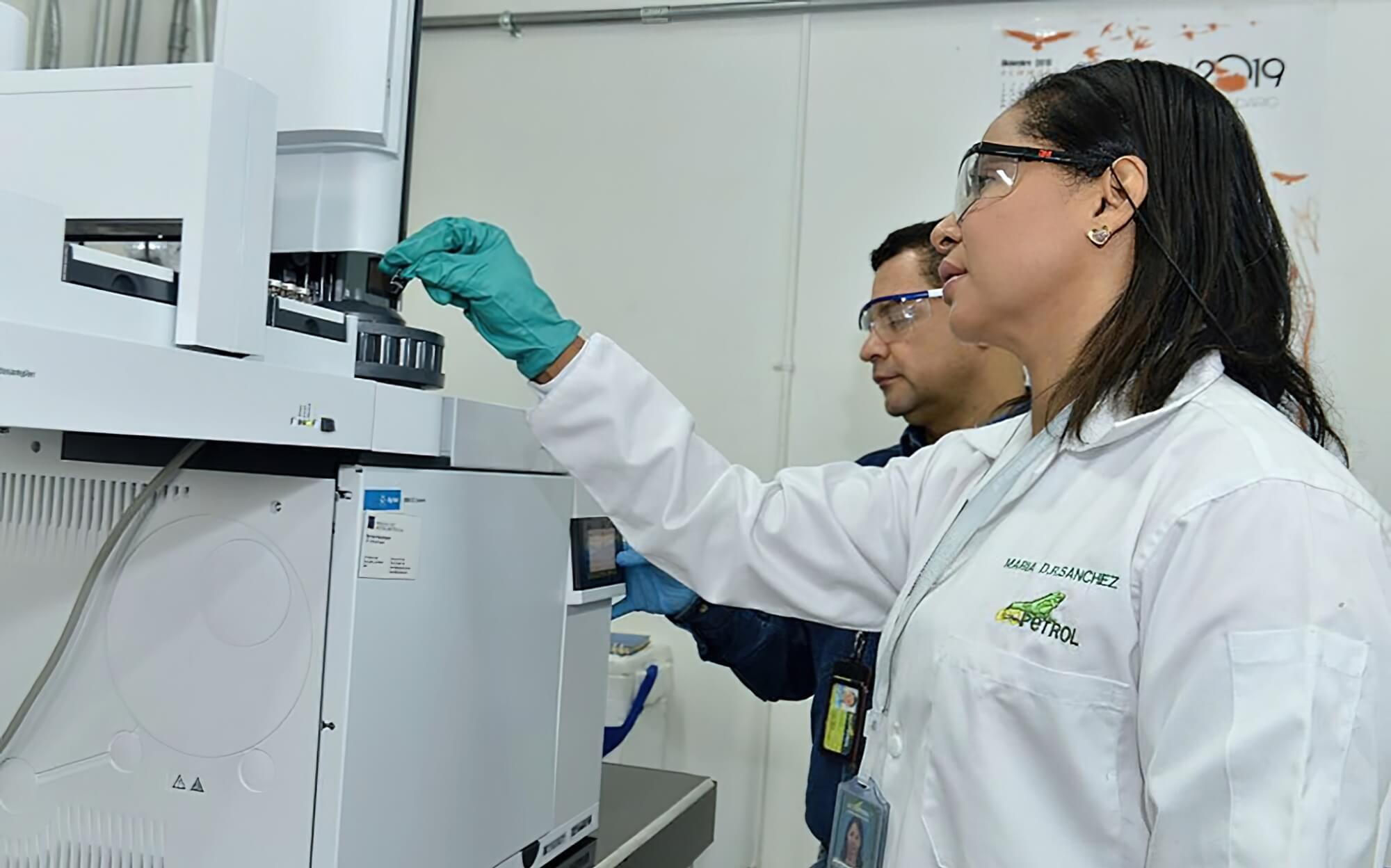
Average training hours per employee and by gender
| Total number of training hours 2021 | Average training hours per employee | |
|---|---|---|
| 560,348 | 80 | |
| 90,146 | 38 | |
| 650,494 | 70 |
Note: Due to face-to-face restrictions during 2020, in 2021 the operation’s own training increased considerably, especially operational excellence training, which increased by more than 34% compared to the previous year. Taking into account that this type of training applies to areas with large populations and mostly men (operations and maintenance), a high numerical impact was generated in the total number of training hours for Ecopetrol. Discriminating the training in themes for administrative areas, where the number of women is greater than in the operation, the average hours of training for women is similar to the average hours of training for men, as can be seen below and as it has been in the last years.
Average hours of training in administrative topics
| Total number of training hours 2021 | Average training hours per employee | |
|---|---|---|
| 270,813 | 39 | |
| 78,679 | 34 | |
| 349,492 | 38 |
Average hours of training on operational issues
| Total number of training hours 2021 | Average training hours per employee | |
|---|---|---|
| 289,535 | 67 | |
| 11,467 | 25 | |
| 301,002 | 63 |
Note: women and men in similar roles have the same training load since it depends on the role and not on gender; however, there are many more men in supervisory and operating positions that, by requiring more hours of training, impact the average.
In 2021, Ecopetrol’s full-time employees received an average of
70 training hours,
an investment of
COP 2.49
million on average
made by the Company per employee.
2
Culture
The behaviors laid out by the
six (6) principles
de la Declaración Cultural de under Ecopetrol’s Cultural Statement were incorporated into the performance evaluation since 2020. The evaluation cycle covers a period of one year, from January to December. The Individual Performance process covers 100% of the employees subject to the performance evaluation
In 2021, Ecopetrol Group’s Cultural Transformation Index (ITC, by its Spanish acronym) stood a
88/100,
and Ecopetrol S.A.’s Index at
87/100,
both maintaining a favorable status. The “Looking at the Mirror” strategy validates the level of appropriation in three dimensions: Culture, Leadership and Environment, and Commitment. The participation of Ecopetrol S.A. workers accounted for
91%
and the Ecopetrol Group
92%
353
team alignment workshops
were held as part of the cultural transformation program, covering close to
2,065 people,
including leaders and collaborators. The focus was on: The generation of trust and emotional security, Leaders as the engine of transformation, From fear to trust, and An environment free of fear based on innovation.
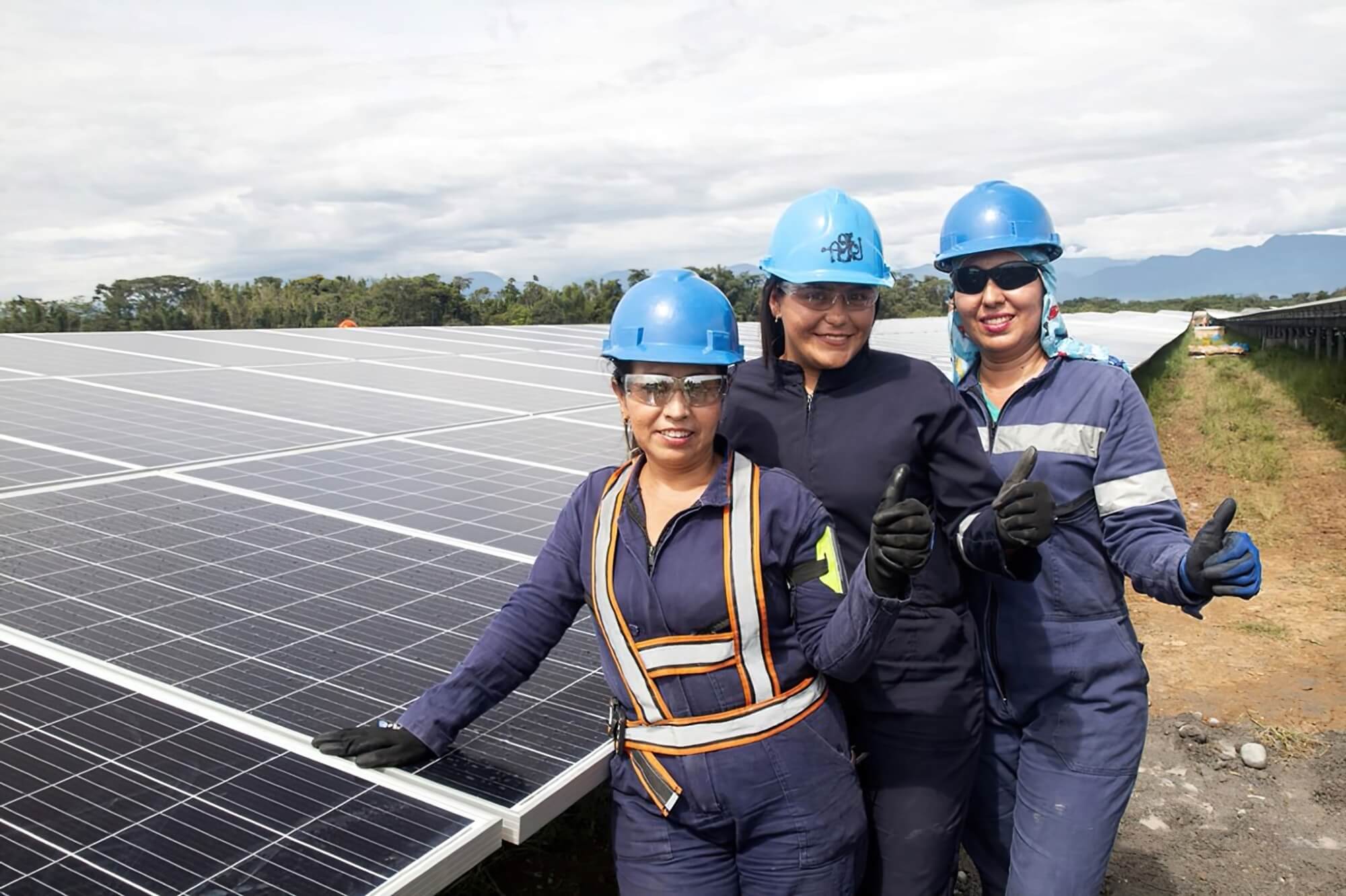
3
Employee Experience
Diversity and inclusion
Ecopetrol applies a zero tolerance approach to discrimination and harassment, which is why it has a Group Policy specifying the Company’s commitment to non-discrimination and the prohibition of all forms of harassment, the measures to train and educate employees on these issues, the process for reporting and escalating incidents, and the corrective and disciplinary measures associated with confirmed behaviors of harassment or discrimination, among others.
In accordance with the provisions set forth in its human rights guidelines and the Code of Ethics and Conduct, Ecopetrol defined clear guidelines establishing the duty of employees to ensure, respect, and foster human rights, diversity, and inclusion. In terms of human talent, the Company develops labor practices aligned with this framework, applicable to the Board of Directors, senior executives, and all the people working in the Company and in the Group. Emphasis is made on the Diversity and Inclusion Program (D&I), based on the principles of meritocracy, equity, and justice. Here are some advancements and achievements:
The team of sponsors and champions continues to grow: The Group has 32 senior management sponsors and 695 volunteer diversity champions.
Talent diversity is advancing: in three (3) years, female participation in leadership positions has increased by 12 percentage points, growing from 18% in 2019 to 29% in 2021 in Ecopetrol, and from 24% to 31% in the Group.
The staff includes more than 597 people with disabilities (6%), 91% of which have a physical disability. Progress continues in the characterization of ethnic self-identification. Ecopetrol has gone from 9 to 26 people who register a same-sex partner.
Internal and external communication drives D&I: in 2021, 225 publications were made (27.8% more vs. the 176 publications in 2020), with more than 24 million views. The contents standing out in June include the LGBTQ Pride month and the #EllaEsAstronauta Program. In terms of internal communication, 22 content publications were made, with more than 75,000 views.
Entrepreneurial support with a diversity and inclusion perspective: the responsible procurement administration has more than 1,500 productive ventures led or integrated mainly by people of difficult labor insertion, conducting more than 32 commercial rounds between 2020 and 2021, with the participation of nearly 450 companies. More than COP 20 billion have been generated in businesses, and 800 jobs supported via entrepreneurship. They have also been accompanied by the Diversity and Inclusion Training Center and its “Emprende con Energía” school, sharing knowledge to strengthen entrepreneurship.
Promotion of inclusive chain employment: dissemination of the diversity policy and the benefits of inclusive employment to more than 4,000 companies. Implementation of the inclusive employment guide in the activities procured, which guides contractors towards sustainable commitments for these jobs; so far this year, 16,622 people have been associated with job placement barriers, including 14,296 women, 120 people with disabilities, 1,145 young people with first jobs, 863 people from groups ethnic groups, and 198 victims of armed conflict.
For more details, including statistics related to incidents of harassment and discrimination, go to the Ethics chapter on page 152.
To ensure that the Company is fulfilling its promise of being a diverse and inclusive space, the following indicators are monitored:
Percentage of employees by job category and gender
(405-1) (WEF 2) (WEF 11)
| Job category | Unit | Men | Women | Total |
|---|---|---|---|---|
| Senior management | # | 25 | 6 | 31 |
| Management | # | 84 | 36 | 120 |
| Middle management | # | 430 | 182 | 612 |
| Supervisors | # | 471 | 6 | 477 |
| Professional technicians | # | 4,106 | 1,974 | 6,080 |
| Operational staff | # | 1,856 | 146 | 2,002 |
| Senior management percentage | % | 81 | 19 | 100 |
| Management percentage | % | 70 | 30 | 100 |
| Middle management percentage | % | 70 | 19 | 100 |
| Supervisor percentage | % | 99 | 1 | 100 |
| Professional technicians’ percentage | % | 68 | 32 | 100 |
| Operational staff percentage | % | 93 | 7 | 100 |
Percentage of employees by job category and age group
(405-1) (WEF 2) (WEF 11)
| Employees by job category | Under 30 years old | Between 30 and 50 years old | Over 50 years old | Total |
|---|---|---|---|---|
| Senior management | 0 | 12 | 19 | 31 |
| Management | 0 | 74 | 46 | 120 |
| Middle management | 0 | 442 | 170 | 612 |
| Supervisors | 1 | 313 | 163 | 477 |
| Professional technicians | 312 | 4,599 | 1,169 | 6,080 |
| Operational staff | 102 | 1,279 | 621 | 2,002 |
| Senior management percentage | 0 | 12 | 61.29 | 100 |
| Management percentage | 0 | 61,667 | 38,333 | 100 |
| Middle management percentage | 0 | 72,222 | 27,778 | 100 |
| Supervisor percentage | 1,333 | 65,618 | 34,172 | 100 |
| Professional technicians’ percentage | 5,132 | 75,641 | 19,227 | 100 |
| Operational staff percentage | 5,095 | 63,886 | 31,019 | 100 |
Percentage of employees by job category and other diversity indicators35
(405-1) (WEF 2) (WEF 11)
| Employees by job category | Unit | Ethnic minority | People with disabilities | LGBTQI+ | Total |
|---|---|---|---|---|---|
| Senior management | # | 1 | – | – | 1 |
| Management | # | 6 | – | – | 6 |
| Middle management | # | 26 | 8 | – | 34 |
| Supervisors | # | 23 | 54 | 3 | 80 |
| Professional technicians | # | 267 | 187 | 20 | 474 |
| Operational staff | # | 234 | 348 | 3 | 585 |
Participation of minorities in the labor force
(405-1) (WEF 2) (WEF 11)
| Category | Participation as a % of total labor force | Participation in managerial positions as a % of the total managerial workforce |
|---|---|---|
| People of African descent | 2.15 | 2.13 |
| Caucasians | 30.3 | 41.6 |
| Indigenous | 0.57 | 0.14 |
| Mestizos | 55.6 | 48.4 |
| Afro-Colombians | 1.05 | 0.43 |
| Other ethnicities | 2.92 | 1.84 |
Participation of women by level of responsibility
(405-1) (WEF 2) (WEF 11)
| Participation of women by level of responsibility | % |
|---|---|
| Participation in the Company’s total workforce | 25.21 |
| Participation in all management roles (junior, middle, and senior management) as a percentage of total management roles | 29 |
| Participation in entry-level or first-level management roles as a percentage of total entry-level roles | 30 |
| Participation in senior management roles (maximum two levels of CEO or comparable) as a percentage of total senior management roles | 28 |
| Participation in income-generating management roles as a percentage of total income-generating management roles (does not include support areas) | 23 |
| Participation in roles related to science, technology, engineering, and mathematics (STEM) | 19 |
(102-8) (405-1) (WEF 2) (WEF 11) (WEF 17)
In 2021 el 6% of full-time jobs were held by people with disabilities,
0.30% by people from the LGTBI community,
4% employed under 30 years of age,
72% between 30 and 50 years of age,
and 23% older 50 years of age.
Proportion of base salary and remuneration between women and men for each job category
(405-2) (WEF 12) (WEF 19E)
| Salary ratio | Average female salary | Average male salary | Proportion |
|---|---|---|---|
| Executive level (base salary only) | 810,579,744 | 836,100,110 | 0.97 |
| Executive level (base salary + other cash incentives) | 1,020,024,680 | 1,074,203,897 | 0.95 |
| Management level (base salary only) | 349,598,090 | 382,223,995 | 0.92 |
| Management level (base salary + other cash incentives) | 404,711,807 | 446,244,317 | 0.91 |
| Non-administrative level | 177,034,973 | 164,073,130 | 1.08 |
Equipares Silver Seal: Ecopetrol is awarded the Equipares Silver Seal (Gender Equity System) with a rating of 98.47%. There are already five (5) Group companies that have favorable gender equity processes under the program.
Inclusive Company Seal: Ecopetrol was awarded the highest recognition for inclusion by ANDI,USAID Colombia’s partnership Program for Reconciliation, ACDI/VOCA Colombia, and Deloitte.
Global Diversity, Equity, and Inclusion Benchmark (GDEIB): In the maturity verification of the GDEIB standard, Ecopetrol was given the score of 4.0/5.0 (Progressive level) by expert panelists authorized by the Center for Global Inclusion.
Friendly Biz Corporate Seal: Ecopetrol received this seal, which is granted by the Merchants Chamber LGBT Colombia and audited by Future Builder to companies committed to respecting and including the LGBT+ community.
Club del 30%: Ecopetrol adheres to this initiative that fosters greater participation of women in Boards of Directors.
United Nations Women’s Empowerment Principles (WEPs): Ecopetrol advances in the rating, from 87 to 91 points.
Ecopetrol adheres to the UN’s principles and standards of conduct for companies that address and prevent discrimination against the SOGI (Sexual orientation and Gender Identity or LGBTIQ+) population.
Ecopetrol Group’s score of
4.5/5.0
for Worker Satisfaction with their work environment and well-being under the new work schemes is also worth noting. Time economy, such as the smart use of time to achieve balance between personal and work life, and the implementation of WPA, Microsoft’s tool to obtain information for managing different work habits and identifying actions for greater balance between work and personal life.
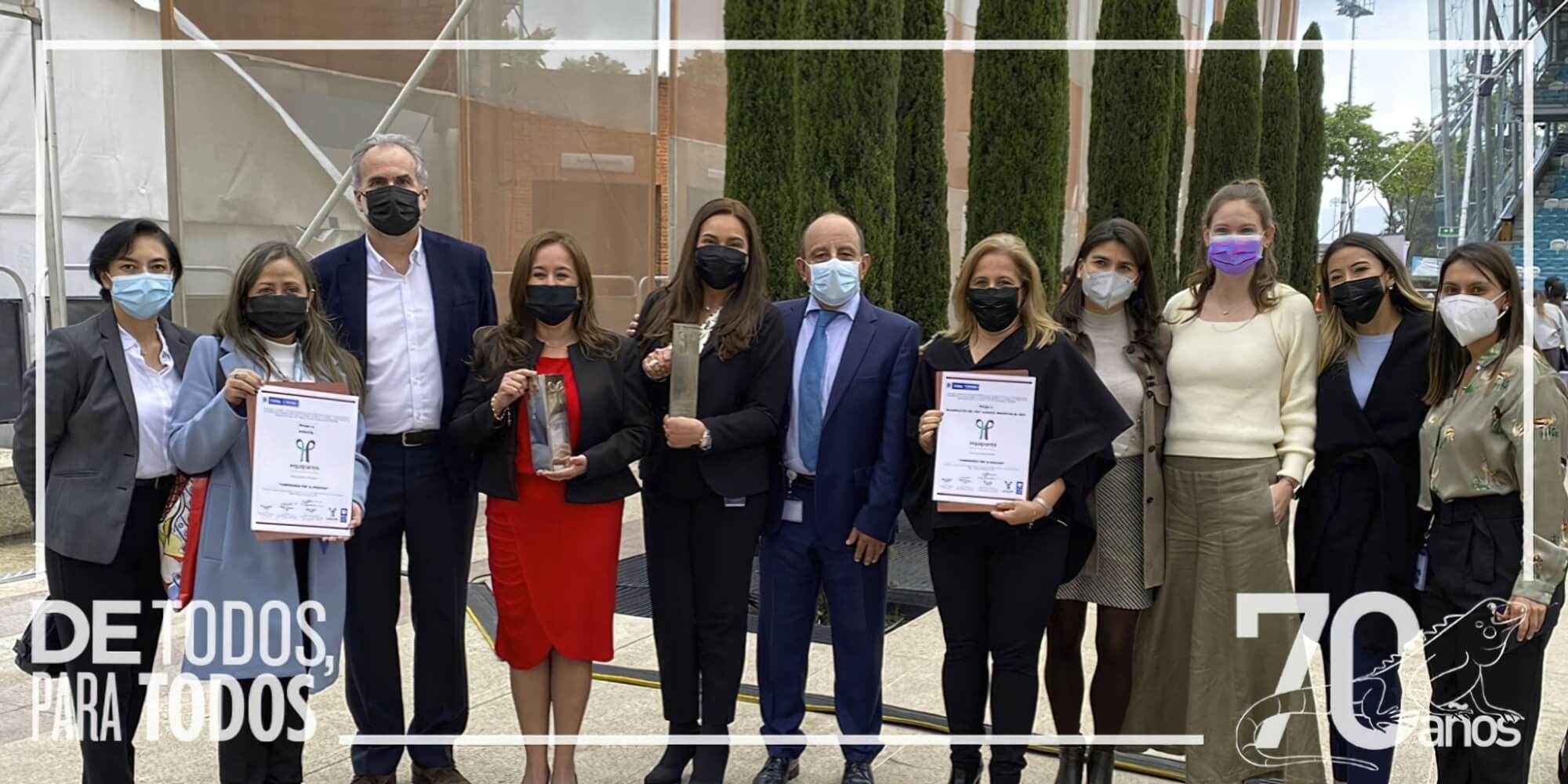
Mobility
Ecopetrol has mechanisms that facilitate the mobility of workers within the Group and to and from external organizations. Also to transfer them to different regions in the country within the Company, under principles of equity and ensuring competitive conditions.
Both internal and external mobility can occur at Ecopetrol.
Employee well-being
The Wellness Plan fosters a balance between work and personal life and the achievement of good physical and emotional health for workers to develop their full potential and contribute to the sustained growth of the Company’s strategy. This plan incorporates three (3) interrelated pillars:
Have fun
Share
Take care of yourself
Performance evaluation
The percentage of employees by gender and job category that have a periodic performance evaluation process is 100% of the eligible population. They are those workers with a contract as of December 31, 2021, who joined the company before September 30, and who do not have absences of more than 270 days.
Of the 9,322 workers of Ecopetrol S.A., 9,191 were eligible as of December 31 and of these, 100% have a performance evaluation process for 2021.
Performance Evaluation
| Category | Men with performance evaluation | Women with performance evaluation | % Men of the total category | % Women of the total category | Total position level | % position level |
|---|---|---|---|---|---|---|
| Senior Management | 25 | 6 | 0.27% | 0.07% | 31 | 0.34% |
| Management | 84 | 35 | 0.91% | 0.38% | 119 | 1.29% |
| Middle management | 430 | 179 | 4.68% | 1.95% | 609 | 6.63% |
| Supervisors | 473 | 6 | 5.15% | 0.07% | 479 | 5.21% |
| Technical professional staff | 4,054 | 1,968 | 44.11% | 21.41% | 6,022 | 65.52% |
| Operational staff | 1,822 | 109 | 19.82% | 1.19% | 1,931 | 21.01% |
| Total | 6,888 | 2,303 | 74.9% | 25.1% | 9,191 | 100% |
100% of Ecopetrol workers are recurrently evaluated against the fulfillment of previously defined objectives. 6.9% of workers also undergo a multidimensional evaluation that includes a feedback process from their leaders and co-workers.
Labor Benefits
(401-2) (WEF 18)
Succession
The Succession program continued in Ecopetrol Group, where leaders and candidates for succession are assessed to define development plans for them and prepare them in advance. This is a cyclical process, and it is reviewed each year to include new critical leadership positions and new candidates as potential successors. This process is one of the Company’s key resources to ensure the filling of leadership vacancies.
370
critical leadership roles subject to succession,
with a growth of
27 %
compared to the 290 roles defined in 2019. Of the roles defined in 2021,
24 correspond to senior management levels,
120 to managerial levels,
165 to department heads,
61 to coordinators.
There is a total base of
1,000
successor candidates in the Company, with a
25%
25%
growth compared to the 800 candidates in 2019. Of the total population of successors,
37 % (373) are women and
63 % (627) are men.
The results of the process are consolidated at the end of 2021 in
29 talent maps covering all of Ecopetrol Group, with a
16 % growth compared to the 25 maps consolidated in 2020.
Development and Leadership
Support to leaders continued throughout different development strategies.
The School of Culture and Leadership extends to 100% of the leaders, successors, and new generations.
It includes a development model consisting of exposure and practice actions, supportive learning, and classroom training.
Tools for autonomous learning, such as GetAbstract (12,000 active users, 19,000 summaries downloaded, mainly on Leadership and Innovation topics) and WOBI (1,035 active leaders), enabled for all Ecopetrol Group employees and leaders.
The scope of the coaching processes was expanded by 36% to a total of 127 leaders (88 men and 39 women). 60+ webinars and web conferences were also held on topics associated with leadership in changing environments, innovation, and strategy.
360° Evaluation of Leadership Competencies: the result obtained was 4.32/5, exceeding the 2019 result by 0.37 points. For this, leadership competencies and behaviors were updated, and the assessment was scoped for new levels of leadership, growing from 347 assessments in 2019 to 552 in 2021.
Women's Leadership
Mentoring Program
As part of the leader development strategies, and in line with the purpose of diversity, a mentoring program was launched for a group of 41 women,
to develop competencies within the framework of the new Cultural Statement, facilitating their access to new job opportunities and empowering them with the necessary skills to exercise more diverse and inclusive leadership roles.
4
Talent Renewal
2021 Employmen
(401-1) (WEF 17)
| Number of new hires | New Hire Rate | |
|---|---|---|
| >Under 30 old | 228 | 50.11 |
| Between 30 and 50 years old | 202 | 44.396 |
| < Over 50 years old | 25 | 50.11 |
| Total | 455 | 100 |
2021 Hires by region
(401-1) (WEF 17)
| Number of new hires | New Hire Rate | |
|---|---|---|
| Women | 198 | 43.516 |
| Men | 257 | 56.484 |
| Total | 455 | 100 |
Nuevas contrataciones por región 2021
(401-1) (WEF 17)
| Number of new hires | New Hire Rate | |
|---|---|---|
| Central | 97 | 21.319 |
| Bogota | 267 | 58.681 |
| Caribbean | 29 | 6.374 |
| Orinoquía | 44 | 9.67 |
| South | 13 | 2.857 |
| East | 5 | 1.099 |
| Total | 455 | 100 |
Internal hiring
(405-2) (WEF 12) (WEF 19E)
| % of internal hiring | Unit of measurement | 2018 | 2019 | 2020 | 2021 |
|---|---|---|---|---|---|
| Total number of hires | # | 767 | 603 | 318 | 455 |
| % of roles filled with internal candidates | % | 40 | 43 | 48 | 51 |
In compliance with Decree 1668/16 regarding local labor, the calls for tender referred to in said rule were published on the page of the Public Employment Service.
Staff turnover
V:
Number of external people employed by Ecopetrol S.A. in 2021.
V:
Number of people dismissed from Ecopetrol S.A. in 2021.
D:
Number of workers at the beginning of the period (January 1, 2021) at Ecopetrol S.A.
F1:
Number of workers at the beginning of the period (January 1, 2021) at Ecopetrol S.A.
F2:
Number of workers at the end of the period (December 31, 2021) at Ecopetrol S.A.
The formula used to compare these variables was as follows:

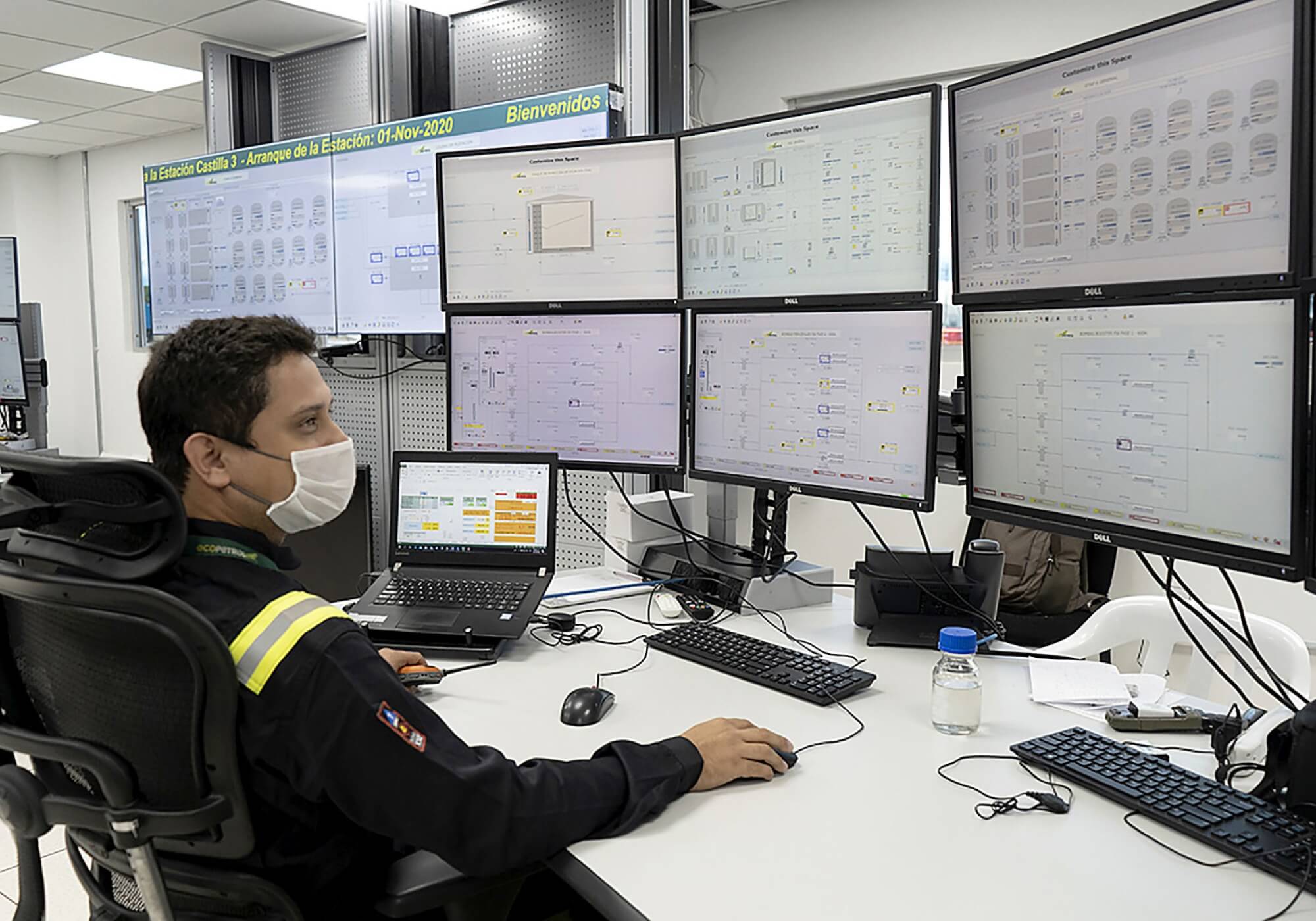
Turnover Rate
| Turnover Rate | |
|---|---|
| Total Company Turnover Rate | 6.11 |
| Management Level Turnover Rate | |
| Extended Steering Committee – President, Vice Presidents, and Managers who are on the extended committee | 9.43 |
| Managers who are not part of the Extended Committee | 4.58 |
| Middle Management | 4.95 |
| Supervisors | 1.82 |
| Professional Technical Level | 5.78 |
| Operational Level | 8.21 |
| Turnover rate by gender | |
| Women | 6.60 |
| Men | 5.95 |
| Turnover rate by nationality | |
| Argentina | 4.55 |
| Colombia | 6.14 |
| The Bolivarian Republic of Venezuela | 3.25 |
| Voluntary Turnover Rate | 2.77 |
| Turnover Rate by Region (Colombia) | |
| Bogotá | 7.48 |
| Caribbean | 5.39 |
| Central | 4.23 |
| East | 2.56 |
| Orinoquia | 6.48 |
| South | 13.92 |
| Turnover rate by age | |
| Under 30 | 37.31 |
| Between 30 and 50 | 4.85 |
| 50 or older | 4.58 |
Note: The data in this table pertains to Ecopetrol S.A., therefore the denominator is 9,320 employees.
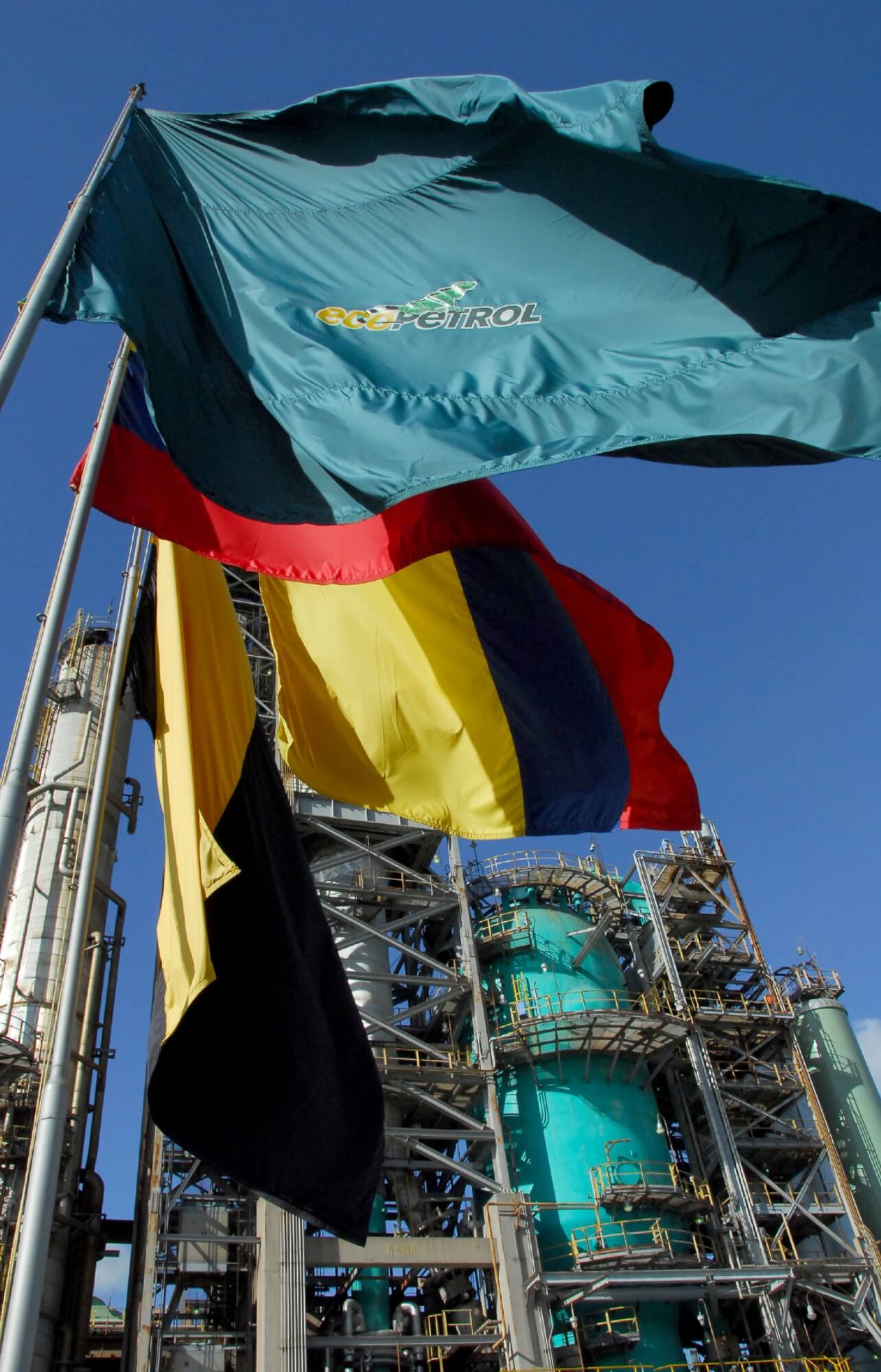
The turnover rate in 2021 is higher compared to the immediately previous year (6.1% vs. 4.8%), which can be explained by three significant factors according to the variables indicated above: The hiring of 180 youths for the Semilleros program, the transformation of the Midstream segment where CENIT took over operations and transfered more than 300 employees to their company, and finally, the Retirement Plan strategy which benefitted more than 90 employees.
The turnover rate at Ecopetrol is within the recommended range (10%) and below the sector average (9.7%).
Semilleros Program
The coverage of the program was expanded as part of the retooling strategy, growing from 21 professionals to 180 (97 men and 83 women) who became part of the third cohort of the Program, with a duration of two (2) years as promoters of change and transformation. The training pillars for the growth of these professionals are: Energy transition, cultural transformation, and digital skills. Program participants have supportive learning (mentoring and tutoring) and exposure (rotations and industrial visits) at their disposal.
The total population of Semilleros is distributed in different areas of the Company, with
30% assigned to the corporate team,
10% to downstream,
24% to support, and
36% to upstream.
High Potential Program
The second cohort of High Potentials was defined with 25 professionals (13 men and 12 women), who were selected after a rigorous process to identify and evaluate the potential for personal growth in the Company and to define compliance with program requirements.
The Development Program lasts three (3) years, and it is conducted collaboratively between Ecopetrol University and Universidad Los Andes in Colombia on topics such as strategic thinking, value chain, leadership skills, management skills, energy transition, cultural transformation, and digital skills.
The population of the second cohort of High Potentials are young people between 27 and 35 years of age. In line with the diversity and inclusion strategy, 52% of the population is male and 48% female.
The High Potentials are distributed in different areas as follows:
36% in the Corporate team,
8% in downstream,
32% in support,
24% in upstream.
Association and Collective Bargaining
(407-1) (WEF 21E)
Ecopetrol is committed to respecting the right to association and collective bargaining, in accordance with the highest international standards on Human Rights. The Company respects and promotes fundamental labor rights. In 2021, it continued working with the coexisting union organizations in the Company, by means of harmonious and constructive labor relations based on direct communication that strengthen union relations with the recognition and respect of rights and duties, to establish healthy relationships to boost the growth of Ecopetrol and the well-being of workers.
As a fundamental basis of these relationships, Ecopetrol fulfills the commitments agreed with union organizations established in the Collective Bargaining Agreement and others, both with the Boards of Directors and with the Sub-directorates of these coexisting organizations in the Company, in compliance with current regulations.
In 2021,
357
relationship opportunities:
187 with National Boards, and
170 with the different sub-directorates at the national level, giving rise to
284 commitments, which were
100% fulfilled.
Similarly, eight (8) extra-conventional minutes were signed with the Workers’ Union (USO, by its Spanish acronym), some with the purpose of providing support to workers during the pandemic.
Durante el año presentaron 104 incidentes de anormalidad laboral con pérdida de horas hombre distribuidos así: 46 Regional Central, 16 Regional Orinoquía, 21 Regional Caribe y 20 Regional Andina Oriente. Adicionalmente, se registró un incidente (Mitin) a nivel nacional relacionado con las protestas contra el Gobierno Nacional.
104 labor abnormality incidents were recorded throughout the year, with losses in man-hours, distributed as follows: 46 Central Regional Unit, 16 Orinoquía Regional Unit, 21 Caribbean Regional Unit, and 20 Eastern Andean Regional Unit. An incident (rally) was also recorded at the national level associated with protests against the National Government.
None of these incidents generated an impact or operational interruption with economic losses for the Company. There were also no strikes recorded in 2021.
There are currently 27 union organizations at Ecopetrol S.A., to which Company workers are affiliated, of which, 18 are industry unions or by economic activity, and nine (9) are Company unions.
Trade Unions
| Industry Unions | Company Unions |
|---|---|
| USO | ASPEC |
| ADECO | ASOPETROL |
| SINDISPETROL | TRASINE |
| UTIPEC | ASTECO |
| SINATRINHI | SINPECO |
| SINTRAMANPETROL | SINPROECOP |
| ASINTRAHC | APROTECO |
| USTRASEN | ASTIPHEC |
| SYNTRAMEN | SITRAECO |
| USOLEODUCTOS | |
| ASINPE | |
| SINTRAPETGAS | |
| SINDINAPETROLEO | |
| SINANPE | |
| SINDEIP | |
| ASOPETROGAS | |
| UNTRAPETROL | |
| SINOME |
In 2021, 48.6% of collaborators at Ecopetrol were affiliated to one of the previous union organizations.
(102-41) (WEF 21E)
Occupational health
and industrial safety
Outstanding
material element
| Impacted stakeholders | Areas responsible for managing the impacts | Ecopetrol segments where the greatest impact is generated |
|---|---|---|
| Suppliers, contractors, and their workers | VHSE | Upstream |
| Clients | Midstream | |
| Investors and Shareholders | Downstream | |
| National State | Comercial | |
| Local State | ||
| Society and Communities | ||
| Associates and Partners | ||
| Employees, retirees, and their Beneficiaries |
Why is the
element material?
Occupational health and industrial safety are a material element at Ecopetrol S.A. because it generates value by providing healthy and safe work environments, free of accidents, sound, aware of people’s well- being, ensuring the least impact on the communities, contributing to the efficiency of the processes, and preserving the Company’s reputation.
Under Ecopetrol's Cultural Statement, and in line with the "Life First" principle, occupational health and safety risks are managed in advance and proactively, prioritizing the protection of the lives of workers, partners, and communities in the areas of operation of Ecopetrol S.A.
How is the material
element managed?
Hazards and risks in the work environments are managed in line with the following pillars:
Mental health and psychosocial risk at work to achieve a balance between work and a healthy work environment
Preventive and Occupational Medicine
Environmental health: Management of risk factors arising from operations in order to mitigate and prevent damage to the health of communities
This, leveraged on legal compliance, occupational epidemiological surveillance, technological innovation, data analytics, financial management, and the HSE culture.

Occupational health and
safety management system
Ecopetrol S.A.’s HSE Management System seeks to establish the necessary elements for the Company to adequately manage risk, to protect life and foster the preservation of the environment. The HSE Management System was established based on current Colombian regulations (Decree 1072 of 2015) and international standards (ISO 45001 and ISO14001).
The System consists of developing a logical and staged process based on continuous improvement, including culture, leadership, policy, organization, planning, and the application, evaluation, auditing, and improvement of actions to anticipate, recognize, evaluate, and control the risks that may affect safety and health at work and in the environment.
This consists of 22 sub-elements, each defining the principle and the basic implementation requirements, which in turn, provide guidance on the documents that specify the application of the basic requirements.
The System covers oil and gas exploration and production processes, the production of refined products and petrochemicals, marketing of hydrocarbons, and administrative and/or business support processes. The process owners are responsible for implementing the sub-elements of the HSE Management System, which must be consistent with the risks associated with each process.
The System is under the leadership of the HSE Vice Presidency, with the participation of all workers and contractors who are an integral part of the Company’s processes, thereby guaranteeing the application of occupational health and safety measures through said system, uplifting worker behaviors, improving working conditions and the work environment, and exerting effective control of hazards and risks in the workplace.
Within the framework of the Life First cultural principle, workers have a tool at their disposal for reporting unsafe behaviors and conditions, either electronically or via telephone. Visits, inspections, and spaces for conversation between leaders and collaborators are also facilitated to report dangerous situations and conditions and strengthen existing controls.
On the other hand, the Company promotes autonomy and self-care as part of its prevention approach. As a fundamental element of on-the-job oversight, when an unsafe act or condition is identified, “Everyone has the obligation and authority to stop the unsafe activity.” This premise has been passed along from senior management to all direct workers and contractors. The next step is to engage in a safety conversation with the people involved in the act or condition to be corrected, to reevaluate together whether the activity can continue safely or whether the activity should be suspended until the unsafe conditions are resolved.
Ecopetrol S.A. offers different means of communication to workers and contractors, where they can raise queries or file complaints about the possible reprisals to which they are exposed after reporting a situation associated with the unsafe activity. For more details on the mechanisms for raising queries and escalating situations that go against the Company’s principles, go to Ecopetrol´s webpage.
Although there are different methodologies for identifying hazards, analyses, and risk assessments depending on the type of hazard, Ecopetrol uses the “bowtie” methodology for hazards associated with industrial safety, and for occupational health hazards and risks, the Company applies the HRA (Health Risk Assessment) methodology. A task risk analysis must be conducted for all activities, which must be prepared in advance and approved by competent personnel from the executing party and by the person in charge of the area where the activity will take place. Each hazard identification and risk analysis and assessment methodology defines intervention priorities by applying controls aligned with the hierarchy established in the ISO 45001:2018 standard. Risk analysis is applied continuously to each activity, and health and “bowtie” risks are updated periodically or each time a new hazard is identified, a new production or technological process is introduced, or a change is made that may pose risks to the health of people or the environment.
All environmental, industrial safety, process safety, and occupational health incidents or alarms that occur in the Company are subject to reporting, registration, investigation, and the implementation of corrective actions, to ensure the incorporation of lessons learned, and thus reduce the probability of recurrence and improve the organization’s performance.
Based on the actual or potential consequence of the incident, the investigative team is assigned as defined by the Company. The causes leading to the incident are determined, as well as the necessary actions to avoid their recurrence by identifying critical factors, immediate causes, unsafe conditions or behaviors, and basic causes or the root cause. The lesson learned is then communicated and incorporated in the applicable area or areas of the Company. Compliance with the actions resulting from the incidents is monitored using the technological tool established by the Company.
In general, the consolidated results of the investigations are analyzed to identify common causes and their trends and define actions to improve the HSE Management System.
(403-3) (WEF 15)
Ecopetrol’s Occupational Health Department is responsible for:
Managing Preventive and Occupational Medicine at Ecopetrol S.A.
Defining and establishing the necessary guidelines, guides, procedures, instructions, formats, and tools for the adequate provision of Occupational Medicine services.
Planning and ensuring the necessary budgetary resources to leverage Occupational Health management.
Providing technical support to the Business Units at Ecopetrol S.A. in Occupational Medicine and other Occupational Health issues, by participating in strategic scenarios to ensure control over the occupational risks in the work environment.
Monitoring compliance with Preventive and Occupational Medicine guidelines and standards.
Participating in the investigation of work accidents and occupational diseases.
To guarantee the quality of occupational health services, Ecopetrol S.A., through the Department of Occupational Health, offers the induction process to the personnel of Preventive and Occupational Medicine companies.
This induction includes the provision of hygiene, ergonomic, and psychosocial results reporting on the health conditions of workers, which must be used for promotion and prevention activities and the structuring of comprehensive action plans targeted to individuals. In addition, a quality assessment of the health services provided at work is conducted in accordance with current regulations in Colombia.
How is the material
element evaluated?
The effectiveness assessment of the Occupational Health strategy is conducted as follows:
Intervention of work environments: Compliance with intervention plans (HRA-Hygiene- Ergonomics-Psychosocial) and risk control of critical trades.
Occupational risk management in projects: Intervention of psychosocial aspects, ergonomic risk management, industrial hygiene, and occupational risk in the New Normal.
Preventive and Occupational Medicine: Periodic comprehensive health, occupational disease, and occupational risk management assessments during the COVID-19 health emergency.
Innovation and Technology: Data analytics to predict and alert possible occupational health risks.
The progress made in Occupational Health management is monitored in different scenarios such as:
(i)
The HSE Committee of the Board of Directors.
(ii)
The Steering Committee.
(iii)
The monthly Operational Excellence Committees of the Vice Presidencies, Managements, and Departments.
(iv)
The monthly Joint Occupational Health Committees (National, Regional, and Local).
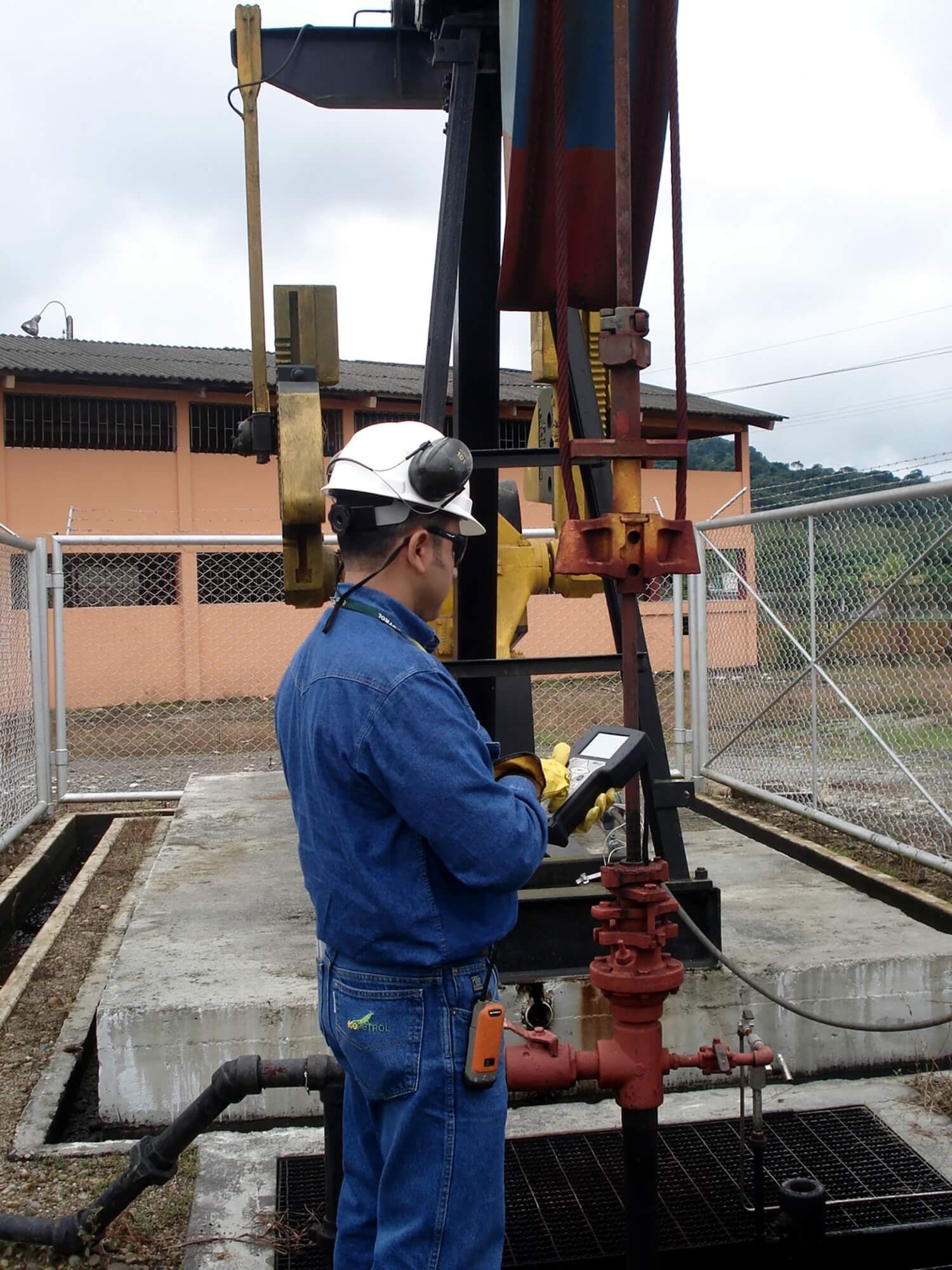
Short, medium, and
long-term goals and projects
SHORT TERM (2022-2023)
- Control the level of risk of identified critical trades.
- Complete diagnosis in the management of high-risk health operations (operation of valves, control rooms, equipment, and tools, closed sampling, and hermetic measurement of tanks)
- Update the Industrial Hygiene and Ergonomics criteria applicable to new projects based on findings in existing facilities and international standards.
- Start incorporating industrial hygiene and ergonomics standards in the phase I high risk projects defined with the Business Unit.
- Incorporate Data Analytics for effective intervention and risk control in the work environment (optimization processes, high risk procedures, characterization of exposure and risk)
- Incorporate technology to monitor the health of workers while executing their tasks, and analysis of the data
- Generate a methodological guide to mitigate the health risks of workers and of the community Medium term (2024-2026).
MEDIUM TERM (2024-2026)
- Evaluate the cost-efficiency of interventions to improve working conditions
- Fulfill 20% of the facilities occupational risk intervention program.
- Continue incorporating industrial hygiene and ergonomics standards in the phase II moderate risk projects defined with the Business Unit.
- Manage health cases using risk detection models with an accuracy greater than 85%.
- Application of the guide in critical areas / processes.
LONG TERM (2027 en adelante)
- Implement systems to reduce occupational exposure to chemical substances in the measurement and hermetic sampling of tanks.
- Implement the recommendations deriving from the ergonomic diagnoses conducted by the Department of Occupational Health, related to the operation of critical valves, control rooms, equipment, and tools.
- Fulfill 50% of the facilities occupational risk intervention program.
- Incorporate the concepts of human factors and their control strategies under incident management into operational processes.
- Incorporate Industrial Hygiene and Ergonomics standards in the new energy production projects developed by the Company.
- Manage health cases using risk detection models with an accuracy greater than 85%.
2021
Management Efforts
1
Intervention of work environments:
- Intervention plans:
- HRA: 90% compliance. *
- Hygiene: 96.67% compliance. *
- Ergonomics: 97.84% compliance. *
- Psychosocial: 100% compliance. *90% goal
- Comparison of the percentage of compliance with psychosocial intervention plans: 2020 compliance: 92.5%- Compliance in 2021: 100%.
- Risk Level Control:
- Intervention of 27 trades with tasks quantified as high risk from the ergonomics and industrial hygiene perspective. 96% Compliance with total trades to be intervened in 2021.
2
risk management
in projects:
In 2021, Ecopetrol advanced in the following actions in occupational
risk management:
- Psychosocial risk management in the new normal
- Evaluation of psychosocial risk factors: 760 evaluations were planned, and 1,011 employees were evaluated.
- Intervention in psychosocial aspects while teleworking: 2,512 were planned and 2,627 teleworking employees were intervened.
- Risk activities identified from Psychosocial Risk factors: -Leadership and administrative roles. 418 leadership roles were evaluated.
- Ergonomic risk management in the new normal.
- Assessments and recommendations for teleworking employees: Assessment of 4,012 employees. 95% coverage of all teleworking employees.
- Verifying compliance with recommendations related to home office conditions: 100% coverage of home office verifications scheduled for the period.
- Verification of workstations in the facilities: 100% coverage of all facility verifications.
- Industrial Hygiene Risk management in the new normal.
- Diagnosis and recommendations for intervening the ventilation conditions in the New Normal. 100% compliance with the Work Plan.
- Verification of compliance with biosafety guidelines in the business units planned for the New Normal (VRP, VDP, Corporate): 100% compliance with the verification plan. (3 business units scheduled / 3 units verified).
- Occupational risk management in Comprehensive Investigation Pilot Projects (Fracking)
- Health Risk Assessment: 100% compliance with the work plan. Delivery of the following outcomes: Identification and characterization of hazards in chemical substances and blends, identification and characterization of the danger of carryback or leachate NORM materials (Naturally occurring radioactive material). Methodologies for exposure assessment and risk characterization.
3
- Periodic Comprehensive Health Assessments.
- Coverage of periodic comprehensive health assessments: 96.23%.
- Occupational disease
- Occupational Disease Rate: 0.52 (rate x 1000).
- Occupational risk management during the COVID-19 health emergency.
- Provision of guidelines to secure the operation during the health emergency and advice and support for implementation.
- 100% compliance with the communications plan for the health emergency.
- Vaccination coverage: 93.4% of the working population with a complete vaccination schedule
4
and Technology
- Data analytics to predict and alert possible occupational health risks.
- 100% compliance with the work plan of the innovation initiative, “How to generate data to predict and alert possible occupational health risks”.
- Digital evaluation of the ergonomic conditions of teleworking employees.
- Compliance with the work plan: 30 assessments of employees working from home using sensory and assisted digital evaluation.
5
Health Committees
- Management of 12 Regional Joint Occupational Health Committees under Resolution 2013 of 1986.
(409-15) WEF
The activities in the hydrocarbon sector are considered of high risk. The risk assessments identify the activities or processes where a sudden release of energy can cause severe injury. The hazards that can cause serious injuries include work at height, intervention of electrical systems, driving vehicles, going into confined spaces, mechanical load lifting, operation of pressure systems, and others. For this type of activities, Ecopetrol S.A. adopts safe practices that define the responsibilities, competencies, and control measures to be followed.
These dangers and their respective controls make up the Rules that Save Lives, which is the communication and assimilation mechanism for workers. The first control principle, if feasible, is to not conduct or try to conduct the activity in another way to eliminate the risk.
Injuries caused by to occupational accidents
(401-1) (WEF 17)
| Occupational illnesses and diseases per employee | Unit of measurement | 2018 | 2019 | 2020 | 2021 |
|---|---|---|---|---|---|
| Number of hours worked | # | 25,408,899.70 | 26,750,733.23 | 27,308,241.84 | 24,533,067.50 |
| Number of deaths resulting from injuries related to workplace accidents | # | – | 1 | 1 | – |
| Number of injuries caused by high-consequence occupational accidents (not including deaths) | # | 1 | – | – | – |
| Number of recordable injuries caused by workplace accidents | # | 16 | 21 | 12 | 9 |
| Death rate related to injuries caused by workplace accidents | Index | – | 0.04 | 0.04 | – |
| Injury rate related to high- consequence workplace accidents (not including fatalities) | Index | 0.04 | – | – | – |
| Recordable injury rate related to workplace accidents | Index | 0.63 | 0.79 | 0.44 | 0.37 |
Injuries related to workplace accidents by contractor
(401-1) (WEF 17)
| Contractors | Unit of measurement | 2018 | 2019 | 2020 | 2021 |
|---|---|---|---|---|---|
| Number of hours worked | # | 82,561,445.52 | 98,856,457.83 | 79,003,968.19 | 87,666,784 |
| Number of deaths resulting from injuries related to workplace accidents | # | 1 | 2 | 2 | 0 |
| Number of injuries caused by high- consequence occupational accidents (not including deaths) | # | 2 | 2 | 1 | 3 |
| Number of recordable injuries caused by workplace accidents | # | 52 | 53 | 34 | 40 |
| Death rate related to injuries caused by workplace accidents | Index | 0.012 | 0.02 | 0.03 | 0 |
| Injury rate related to high-consequence workplace accidents (not including fatalities) | Index | 0.02 | 0.02 | 0.01 | 0.034 |
| Recordable injury rate related to workplace accidents | Index | 0.63 | 0.54 | 0.43 | 0.456 |
No fatal accidents were recorded in 2021; there was a
29 %
decrease
in recordable injuries related to workplace accidents at Ecopetrol S.A. The workplace accidents suffered by employees occurred mainly in equipment and well maintenance activities during processing plant operations and while walking. In 50% of the accidents, the upper limbs were affected, specifically the fingers, with cuts and fractures.
In general, the types of injuries suffered by Ecopetrol S.A. employees were friction or scrapes, blows, overexertion, and contact with elevated temperatures.
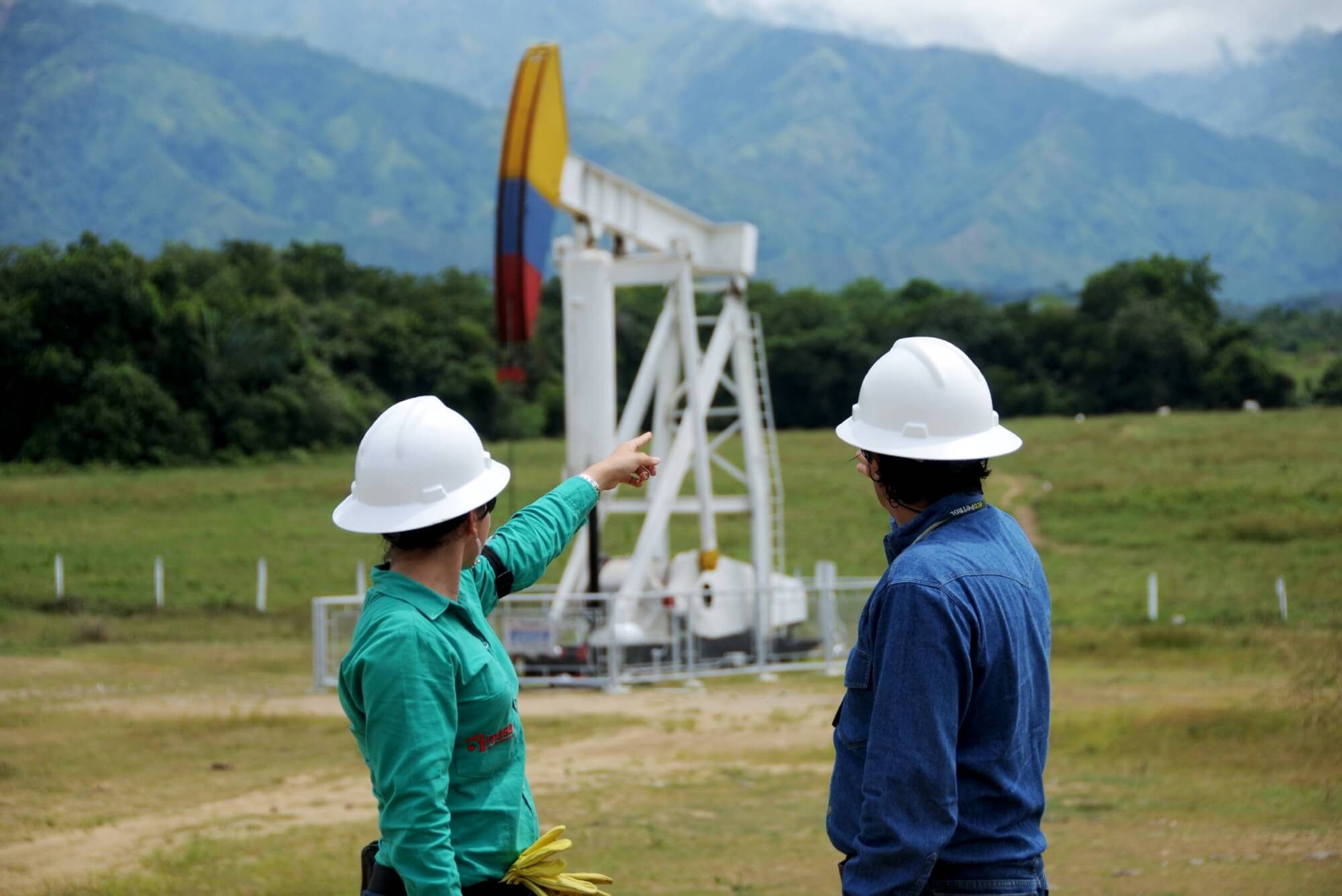
There were no fatal accidents recorded in the contractor population in 2021 at Ecopetrol S.A.
The injuries suffered by contractors due to work accidents at Ecopetrol S.A. occurred mainly in equipment maintenance, drilling, and well maintenance activities, and while walking.
49% of the injuries suffered by contractor employees were in the upper limbs, specifically the fingers. The types of injuries occurred were entrapment, falls, blows, and contact with elevated temperatures.
Occupational illnesses and diseases suffered by employees
(403-10) (WEF 15)
| Occupational illnesses and diseases suffered by employees | Unit of measurement | 2018 | 2019 | 2020 | 2021 |
|---|---|---|---|---|---|
| Number of deaths resulting from an occupational disease or illness. | # | 0 | 0 | 0 | 0 |
| Number of recordable work-related ailments and illnesses | # | 14 | 3 | 1 | 3 |
Injury frequency rate with lost time (employees)
| Injury frequency rate with lost time (employees) | Unit of measurement | 2018 | 2019 | 2020 | 2021 |
|---|---|---|---|---|---|
| LIFTR | 0.35 | 0.49 | 0.26 | 0.12 |
Injury frequency rate with lost time (contractors)
| Injury frequency rate with lost time (contractors) | Unit of measurement | 2018 | 2019 | 2020 | 2021 |
|---|---|---|---|---|---|
| LIFTR | 0.46 | 0.3 | 0.35 | 0.3 |
Total recordable injury frequency rate (employees)
| Total recordable injury frequency rate (TRIFR, by its Spanish acronym | Unit of measurement | 2018 | 2019 | 2020 | 2021 |
|---|---|---|---|---|---|
| Employees | TRIFR | 0.63 | 0.79 | 0.44 | 0.367 |
| Total employee data coverage rate | % | 100 | 100 | 100 | 100 |
Total recordable injury frequency rate (contractors)
| Total recordable injury frequency rate (TRIFR, by its Spanish acronym) | Unit of measurement | 2018 | 2019 | 2020 | 2021 |
|---|---|---|---|---|---|
| Contractors | TRIFR | 0.63 | 0.54 | 0.43 | 0.456 |
| Total contactor data coverage rate | % | 100 | 100 | 100 | 100 |

Process Safety
Outstanding
material element
Sustainable Development Goals

| Impacted stakeholders | Areas responsible for managing the impacts | Ecopetrol segments where the greatest impact is generated |
|---|---|---|
| Suppliers, contractors, and their workers | VHSE | Upstream |
| Society and Communities | VDP | Midstream |
| Employees | VRP | Downstream |
| VGS |
Why is the
element material?
Process safety is designed to achieve the best operational performance by intervening in the highest technological risk, implementing the necessary measures and actions to prevent and mitigate the release of dangerous substances or energy. The impact of these measures is focused on the reduction of operational and occupational accidents with the potential of causing major accidents or disasters, providing an effective management framework for Ecopetrol’s operations, and demonstrating commitment to the first principle of the Cultural Statement, Life First.
How is the material
element managed?
Process Safety is classified as a prominent element in the Sustainability pillar of Ecopetrol’s 2040 Strategy. Ecopetrol’s ambition is to become a global benchmark in industrial safety, adopting best practices and undertaking operations under tolerable risk levels for Process Safety. To this end, the Company works on four (4) fronts:
Coherence, commitment, and visible leadership in process safety
Risk-based process safety management
Trend analysis and learning from experience
Emerging risk management
How is the material
element evaluated?
This element is evaluated using “Process Safety Performance Indicators for the Refining and Petrochemical Industries” (API 754), issued by the American Petroleum Institute. The results are monitored in different instances and at different frequencies: in the weekly HSE reports, in the monthly performance report submitted to Ecopetrol’s Executive Committee and Board of Directors, and in the monthly HSE committees of the businesses.
Tier 1 Frequency Rate of Process Safety Incidents
Measures the number of incidents involving an unplanned or uncontrolled loss of containment of any material (including non-toxic or non-flammable substances such as steam, hot condensate, nitrogen, compressed CO2, or compressed air), giving rise to the consequences defined in the current edition of API 754 to be classified as “Tier 1”, per million man hours worked at all Ecopetrol S.A. facilities. Incidents N1 (“Tier 1”) are considered those with the greatest consequences, such as disabling injuries or fatalities, major impacts on the environment, fire or explosion damage in excess of USD100,000, or material containment losses in excess of the limits defined by API 754
Tier 2 Frequency Rate of Process Safety Incidents (IFSP N2)
Measures the number of incidents involving an unplanned or uncontrolled loss of containment of any material (including non-toxic or non-flammable substances such as steam, hot condensate, nitrogen, compressed CO2 or compressed air), giving rise to the consequences defined in the current edition of API 754 to be classified as “Tier 2”, per million hours worked at all Ecopetrol S.A. facilities. Incidents N2 (“Tier 2”) are considered of less consequence than N1 (“Tier 1”) according to API 754.
Short, medium,
and long-term goals
and projects
Short term (2021-2023)
Goals
- Tier 1 Frequency rate of process safety incidents (IFSP N1) at 0.05
- Tier 2 Frequency rate of process safety incidents (IFSP N2) 15% lower compared to 2020.
Projects
- Incorporation of guidelines for the evaluation of NATECH risks (events of natural origin that cause technological accidents).
- Establishment of onsite and off-site individual risk measurement for all Ecopetrol facilities.
- Definition of the process safety strategy for the Alternative Energies portfolio.
- Update of Ecopetrol’s risk assessment matrix.
Medium term (2024-2030)
Goals
- Tier 1 Frequency rate of process safety incidents (IFSP N1) at 0.04.
- Tier 2 Frequency rate of process safety incidents (IFSP N2) 30% lower compared to 2020.
Projects
- Prioritization and strengthening of asset integrity based on risk management.
- Definition of Process Safety competencies for leadership roles.
- Inclusion of hydrogen, gas, and offshore in existing process safety guidelines.
Long term (2031-2050)
Goals
- Tier 1 Frequency rate of process safety incidents (IFSP N1) at 0.04.
- Tier 2 Frequency rate of process safety incidents (IFSP N2) 50% lower compared to 2020.
Projects
- Management of individual onsite and off-site non-tolerable risk values.37
- Attain the Process Safety competencies defined for all roles that have an impact on process safety.
- Inclusion of NATECH in dynamic risk management.
37. Individual Risk: Fatality risk to which an individual is exposed annually for being in certain location surrounding an activity.
2021
Management Efforts
Performance
of key indicators
Tier 1 Incident frequency rate (IFSP N1): the result obtained in 2021 was
0.03
incidents per million hours worked,
which represents a positive performance with respect to the maximum limit of 0.05 established for the reporting year (2021).
IFSP N1
| Tier 1 Incident Frequency Rate (IFSP N1): | Unit of measurement | 2018 | 2019 | 2020 | 2021 |
|---|---|---|---|---|---|
| Number of incidents per million hours worked | # | 0.05 | 0.03 | 0.05 | 0.03 |
| Data coverage (expressed in % of employees) | % | 100 | 100 | 100 | 100 |
Tier 2 Incident Frequency Index (IFSP N2):
Ecopetrol’s result was
0.09,
which is rather positive given the maximum limit of 0.17 established for 2021
Incidents occurred in the period
| Cantidad de incidentes | Unit of measurement | 2020 | 2021 |
|---|---|---|---|
| Tier 1 | # | 5 | 3 |
| Tier 2 | # | 5 | 9 |
Note: Tier 1 and 2 process safety incidents are events related to the Company’s industrial processes that gave rise to a loss of containment of a hazardous substance.
These Tier 1 and Tier 2 incidents (2021) consequently affected individuals, the environment, and the infrastructure.
Fulfilling challenges and
strengthening process management
Risk reduction by 17% in high consequence scenarios, at tolerable risk levels38.
Integration of comprehensive HSE change management, related to changes in infrastructure and technology, organizational changes, and procedural changes.
Incorporation of Process Safety guidelines for YNC and Hydrogen initiatives, to identify and manage the risks in these initiatives and proactively prevent the occurrence of process safety incidents.
Implementation of the Gap Analysis tool to evaluate compliance with Process Safety requirements in the operational areas.
Implementation of tools and learning programs to strengthen Process Safety competencies.
Participation in the national legal regulatory definition of Process Safety.
38. Tolerable risk: it has a maximum valuation M in the matrix defined in the corporate guidelines.
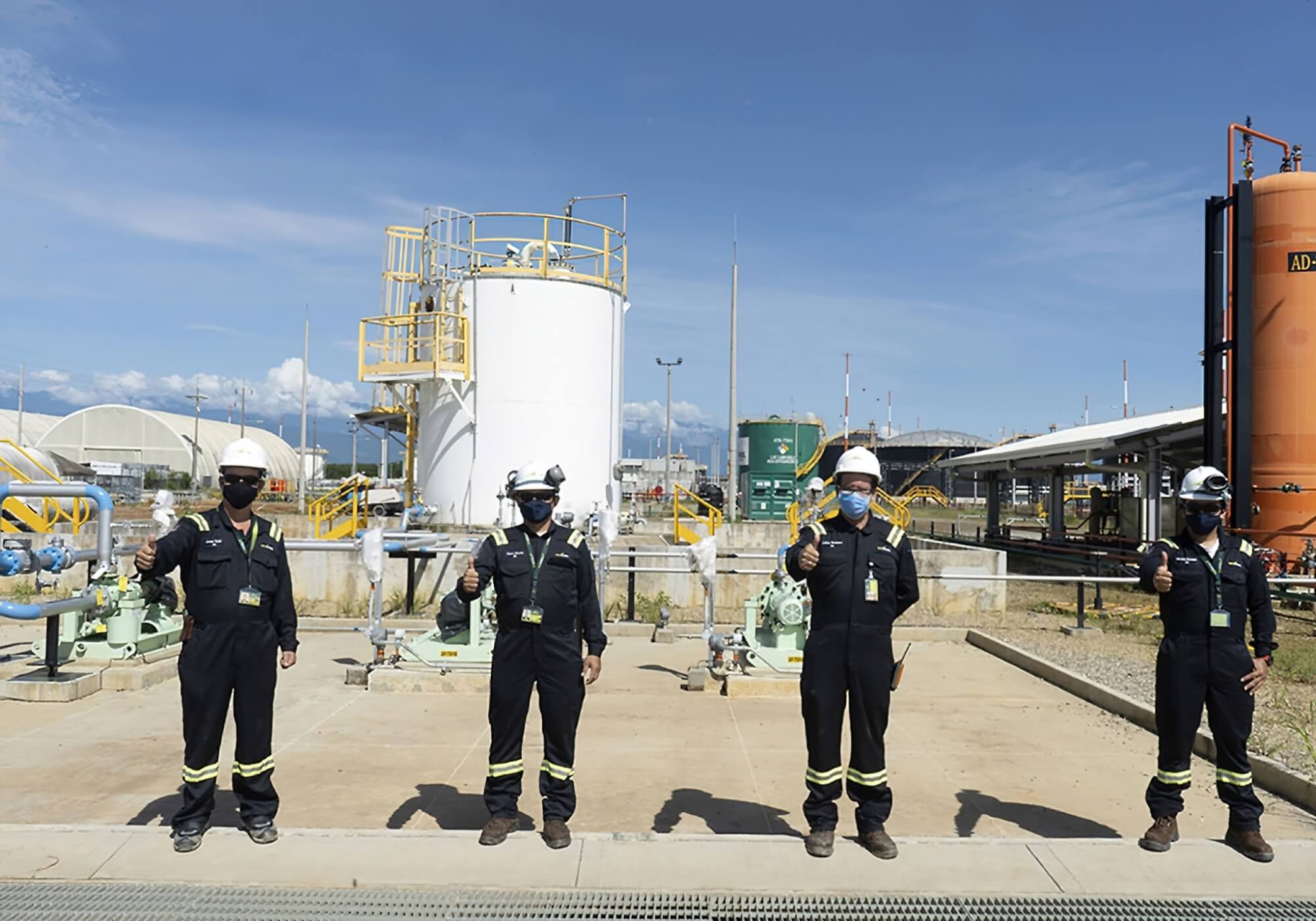
Roadmap
Community Engagement39
Community Investments
Community investments
The Social Development Portfolio invests in the three (3) strategic pillars of the Community Engagement Strategy. The investment made in 2021 for each of these pillars is represented as follows:
Investments by Strategic Pillars in 2021
| Strategic Pillar | Strategic Investment Value (COP millions) | Compulsory Investment Value (COP millions) | Total Value(COP millions) |
|---|---|---|---|
| Investment for Engagement | 15,838 | 10,751 | 26,589 |
| Social investment | 183,219 | 10,808 | 194,027 |
| Subtotal | 199,057 | 21,559 | 220,616 |
| Physical security | N/A | N/A | 206,173 |
| Total | 199,057 | 21,559 | 426,789 |
Note: In the 2021 period, more than COP 156 million were also executed in sponsorships (commercial initiatives).
Community engagement focuses on the three (3) strategic options prioritized in the Roadmap:
(i)
Revitalization of local economies
(ii)
Education
(iiI)
Access to Public Services
39. Given the evolution and growth of Ecopetrol Group, the Community Engagement Strategy is dynamic and subject to updates, in alignment with the Group’s Strategy. Considering the foregoing, the guidelines of the Community Engagement Strategy are being updated in accordance with the new pillars of the corporate strategy.
These strategic options are deployed in five (5) lines of social investment:
1
Education, Sports, and Health (Ecopetrol Educa).
2
Inclusive Rural Development (Ecopetrol al campo).
3
Entrepreneurship and Business Development (Ecopetrol Emprende).
4
Public and Community Infrastructure (Ecopetrol Construye).
5
Public Services (Ecopetrol Agua y Vida and Ecopetrol Conecta).
In addition to social investments, Ecopetrol also invests in engagement, in the form of actions for institutional and community strengthening, to empower suitable and trained actors to take on the challenges of transforming their territories.

Education, Sports,
and Health (Ecopetrol Educa)
Investments in education and sports improve school quality, coverage, and retention. With this, Ecopetrol contributes to promoting the rights of children and adolescents, the dissemination of culture, the peaceful resolution of conflicts, and the strengthening of democratic principles. Ecopetrol has set the goal of benefiting more than
626,000 children and youth,by 2024, equivalent to
9%
enrollment in public institutions in the country. In 2021,
102,715 students
benefited from initiatives associated with greater coverage, greater retention, and better quality, as indicated below:
- Coverage extended to higher education: 1,678 students were supported in different modalities thanks to the Ecopetrol High School program, the Generation E Program of the Ministry of National Education and Icetex, and the Utopia Program, in partnership with Universidad de la Salle.
- Improvement of educational infrastructure: the construction of the Henry Daniels school in the municipality of Castilla La Nueva was completed, and eight educational centers were ungraded, benefiting more than 5,000 students in the departments of Meta, Putumayo, Santander, and Huila.
- Provision of school furniture, benefitting more than 12,700 students in the departments of Norte de Santander, Santander, Meta, Casanare, Huila, Putumayo, Antioquia, and Bolívar.
- 50,400 school kits handed out in the educational centers located in Ecopetrol’s areas of influence, in the departments of Meta, Casanare, Huila, Cundinamarca, and Santander.
- Implementation of pedagogical models in rural multi-grade schools, training for teachers, and handing out pedagogical material for students returning to class, thereby beginning the execution of 12 educational alternation projects, and lectures on peace and environmental education for the benefit of more than 39,000 students and teachers in 229 schools around the country.

Health
(Ecopetrol Salud)
- Provision of medical equipment: As part of the support for the Covid-19 health emergency, 1,020 pieces of medical equipment were delivered to different hospitals nationwide.
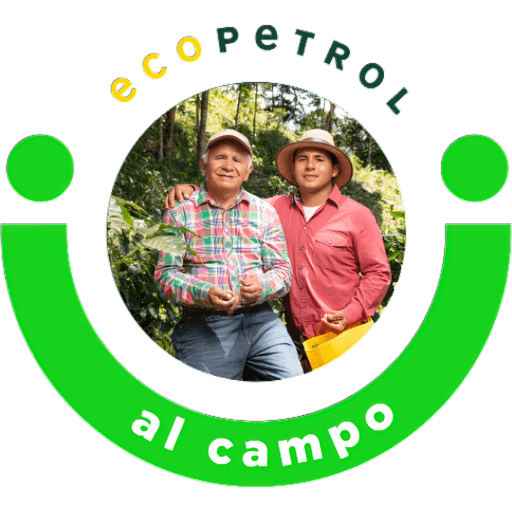
Inclusive Rural Development
(Ecopetrol al campo)
six (6) projects
were completed in 2021, involving
1,099 small rural producer
families from Meta, Casanare, Arauca, Magdalena, and Santander. Two (2) of the most relevant projects helped strengthen productive chains:
- Sustainable panela production in the Sierra Nevada de Santa Marta with the Arhuaco Community and in partnership with the United Nations Office on Drugs and Crime (UNODC).
- Citrus fruit production in the municipality of Saravena, by providing technical, organizational, and commercial support to 120 small producers to improve their production and ability to generate income.
In 2021, more than
10 commercial partnerships
were established between producer associations and Ecopetrol’s cafeteria operators and other related businesses. On the other hand, farmer’s markets were organized in the municipalities of Castilla, Villavicencio, Guamal, Akacías, and Puerto Gaitán, with theobjective of revitalizing local economies as a strategic option for local development.

Entrepreneurship and
Business Development
(Ecopetrol Emprende)
With the purpose of strengthening the business fabric by generating entrepreneurship and innovation capacities, thus favoring income generation and employment, Ecopetrol has set the goal of reaching
5,878 beneficiaries
by 2024.
Some of the most relevant initiatives in 2021 include the consolidation of the Ecopetrol Emprende program, executed in partnership with CREAME Business Incubator, whose objective is to support economic reactivation by accompanying entrepreneurs and revitalizing the business fabric. In its first year, this program benefited
425 entrepreneurs and Small and Medium Enterprises (PYMES, for the Spanish acronym)
from 33 municipalities
in the South, Orinoquía, Piedemonte, Central, Arauca- Catatumbo, Caribbean, and East Regional Units, with technical assistance aimed at reviewing business models to help them adapt to the New Normal.
Another program worth highlighting is Youth 4.0, Innovating and Transforming Territories, whose purpose is to foster a mindset for innovation and entrepreneurship, and offer training in technologies and fourth industrial revolution (4RI) skills, to teenagers between the ages of 14 and 28 in the municipalities of Puerto Wilches, Tauramena, and Villavicencio.
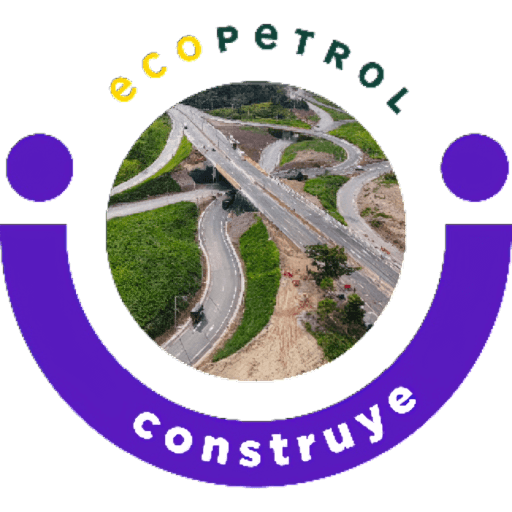
Public and Community
Infrastructure
(Ecopetrol Construye)
To promote the reactivation of local economies, local and national partnerships were strengthened in 2021 with territorial entities, unions, and international organizations to diversify the infrastructure investment strategy.
Road infrastructure
Different projects were completed in 2021 for the intervention of
62 Km of roads
that benefit
more than 70,000 people,
thereby contributing to the revitalization of the regions and the generation of employment, mostly local. Some of the most relevant projects include the rehabilitation of the Soberanía road in the department of Arauca, the improvement of the El Pedral – Puente Sogamoso Road in the municipality of Puerto Wilches, the improvement of urban roads in Sabana de Torres, department of Santander, and the improvement of roads in Aguazul, department of Casanare, among others.
Additionally,
19 projects are under the direct execution
of Ecopetrol for the improvement of
236 Km of tertiary roads.
Community
public infrastructure
The intervention and construction of 15 community buildings for cultural development were completed in 2021 in the Orinoquía regional unit, as well as the promotion of coexistence in the Central and Eastern regional units.
Public Services
(Ecopetrol Agua y Vida and Ecopetrol Conecta)
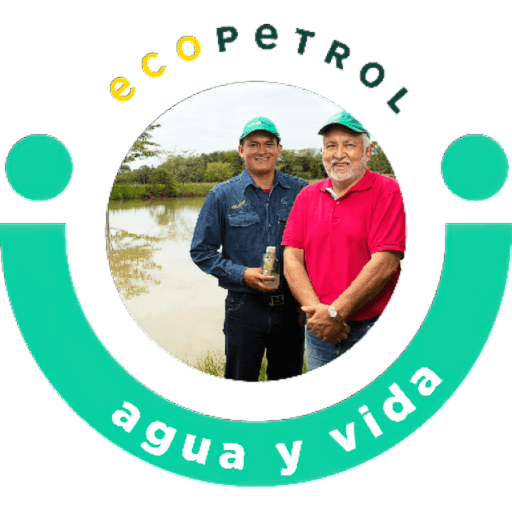
Ecopetrol Agua y Vida -
Drinking water and basic sanitation
Construction works were executed in 2021 for the protection, stabilization, and to the catchment system of the urban aqueduct in the municipality of Puerto Gaitán, benefiting
8,166 inhabitants.
Projects are being undertaken to benefit more than 900,000 people by 2022: the metropolitan aqueduct in the municipalities of Cúcuta, Villa del Rosario, and Los Patios, the construction of the San Silvestre Wastewater Treatment Plant (WWTP) in Barrancabermeja, and the implementation of four (4) individual water purification solutions in educational institutions in the municipality of Puerto Wilches.
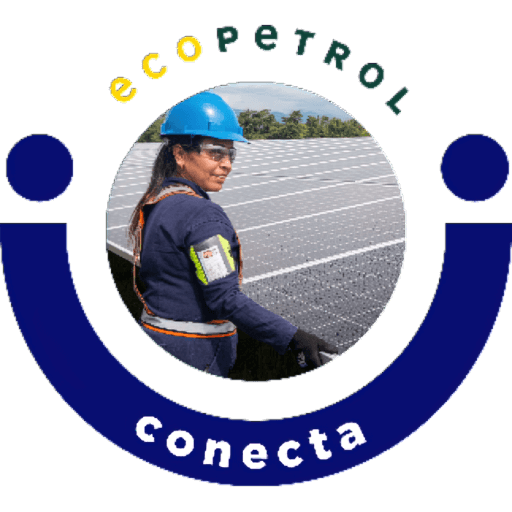
Ecopetrol Conecta -
Energy and gas
By means of Ecopetrol Conecta, the Company helps close gaps in the access to public energy and gas services. Eight (8) projects were completed in 2021, facilitating access to residential public gas services through the construction of service grids, the expansion of coverage, the construction of distribution and marketing networks, and the development of service massification plans. Projected benefitted
6,132 users,
improving the quality of life of these families.
Investments for Institutional
and Community Strengthening
In 2021,
59,979 people
benefited from institutional and community strengthening programs and projects. Some of the projects executed include the empowerment of youth leaders in Puerto Wilches (180 beneficiaries), in partnership with the United Nations Office on Drugs and Crime (UNODC), and another 650 youth from the rest of the country, in partnership with Asociación Amigos of the National Museum. Also, the qualification of
64 Community Action Boards in Meta,
in partnership with the Administrative Unit for Solidarity Economy Organizations, so that these institutions develop capacities as managers of their own territories, as specified by Law.
Execution of Social
Investment and Engagement
Social investment and engagement projects and initiatives (strategic/voluntary and mandatory) were executed in the amount of
COP 220,616
million in 2021
(See Graph 36), with the signing of additional social investment and engagement conduits to be executed in the next terms. There is a 3% decrease in the amount executed in relation to the previous period, due to capital efficiencies in the execution of resources to support the COVID-19 emergency.
Ecopetrol’s Execution of Social Investment and Engagement from 2017 to 2021 (COP millions)
The strategic (voluntary) and mandatory investments executed in 2021 are classified in the following lines of investment (See Graph 37), generating impact on the different dimensions of Local Development (See Table 120).
Social Investment and Engagement in 2021 (COP millions)
Results by line of social investment and engagement*
| | | Investment Lines | 2021 Results |
|---|---|---|
| 1. | Education, Sports, and Health (Ecopetrol Educa) | Number of Beneficiaries: 102,71540 No. Structures Built: 1 No. Infrastructures Intervened: 8 |
| 2. | Inclusive Rural Development (Ecopetrol al Campo) | No. Indigenous Communities Supported: 1 No. Small and Medium Producers: 1,099 |
| 3. | Entrepreneurship and Business Development (Ecopetrol Emprende) | Number of Beneficiaries: 491 |
| 4. | Public and community infrastructure. (Ecopetrol Construye) | Km. of Roads Intervened: 32 No. Structures Built: 200 No. Infrastructures Intervened: 15 |
| 5. | Public Services(Ecopetrol agua y vida y Ecopetrol conecta) | Water No. of people: 8,166 Gas No. Users Connected: 6,132 Basic sanitation No. of people: 160 |
| 6. | Engagement – Institutional and community strengthening | Health emergency – COVID19 No. Institutions Strengthened: 21 Institutional and Community Strengthening Humanitarian Aid – No. Markets: 2,200 Indigenous Communities Supported: 11 No. of Beneficiaries: 59,979 No. Institutions Strengthened: 1 |
* Certified goals in 2021
40. Includes 79,916 program beneficiaries to help children return to school in the post-pandemic framework.
Ecopetrol S.A.'s social investment portfolio is built by identifying opportunities to contribute to local development under the defined social investment lines.
The projects and initiatives are prioritized in consultation with Stakeholders (national, departmental, and local governments, society, and the community), and are rigorously formulated and structured as an integral part of the Company’s environment plans to facilitate operations.
Mandatory investments consist of those made by Ecopetrol S.A. in order to comply with the social obligations laid out in the contracts with the National Hydrocarbons Agency (ANH). This are also enforced by the environmental authorities as part of the permitting and licensing processes and other obligations, such as those arising from the processes to guarantee the right to prior consultation, which are executed not only to meet legal requirements but also as opportunities to improve local socioeconomic conditions.
With respect to 2020, there was a significant increase in the Public Services investment line in 2021, with an additional investment of more than
COP 40,000 billion,
including projects such as the Cúcuta Aqueduct, with a total execution of
COP 97,977 billion
and the Education, Sports, and Health line, with an additional investment of more than
COP 8,000 billion.
The latter includes the “Generación E” Corporate Project, with an execution of
COP 9,000 billion
and the Furniture Provision Project in educational institutions of Rionegro, Sabana de Torres, San Vicente de Chucurí, Barrancabermeja, and San Martín, with an execution of
COP 3,064 billion.
Of the investments distributed by regional unit, Arauca Catatumbo stands out in the Public Services investment line. In addition, the Central regional unit executed more than
COP 7,000 billion
in the improvement of the El Centro Road (Barrancabermeja), the provision of medical equipment for the Middle Magdalena Regional Hospital, and the provision of furniture for GMA (Management of Development and Production Operations of Mares) municipalities. The Orinoquía regional unit executed more than
COP 8,000 billion
in the implementation of an inclusive food supply model (FAO) in the municipalities of Villavicencio, Acacías, Castilla, and Guamal. Additionally, the gasification for 1,500 inhabitants of township 4 and 7 in the municipality of Villavicencio, and the provision of medical equipment during the health emergency. (See graph 38)
Graphs 37 and 38 include investments made through the Community Benefit Programs – PBC (mandatory investment).
In 2021, Ecopetrol invested COP 14.615 billion in PBCs, executed in 68 projects nationwide.
Ecopetrol articulates and generates synergies between mandatory social investments such as PBCs and voluntary investments. The Company promotes and facilitates the confluence of available mechanisms and sources of social investment together with local and national governments, in order to maximize the impacts of said projects in the communities.
Ecopetrol’s Social Investment is aligned with State social policies and with the goals proposed in the 2030 National Agenda and the SDGs.
Public Works for Taxes
In 2021, Ecopetrol S.A. continued to lead the implementation of the Public Works for Taxes mechanism41 in Colombia, achieving the highest participation in the country, with
four (4) projects
awarded this term in the amount of
COP 36,836 billion
benefitting more than
89,000 Colombians.
With the allocation of these projects, Ecopetrol accumulates a total of 29 projects, since the inception of the program, in the amount of COP 318.490 billion.
In 2021, Ecopetrol completed
11 projects
in the amount of
COP 119,175 billion
benefitting more than
103,000 inhabitants in
31 municipalities
in nine (9) departments
around the country.
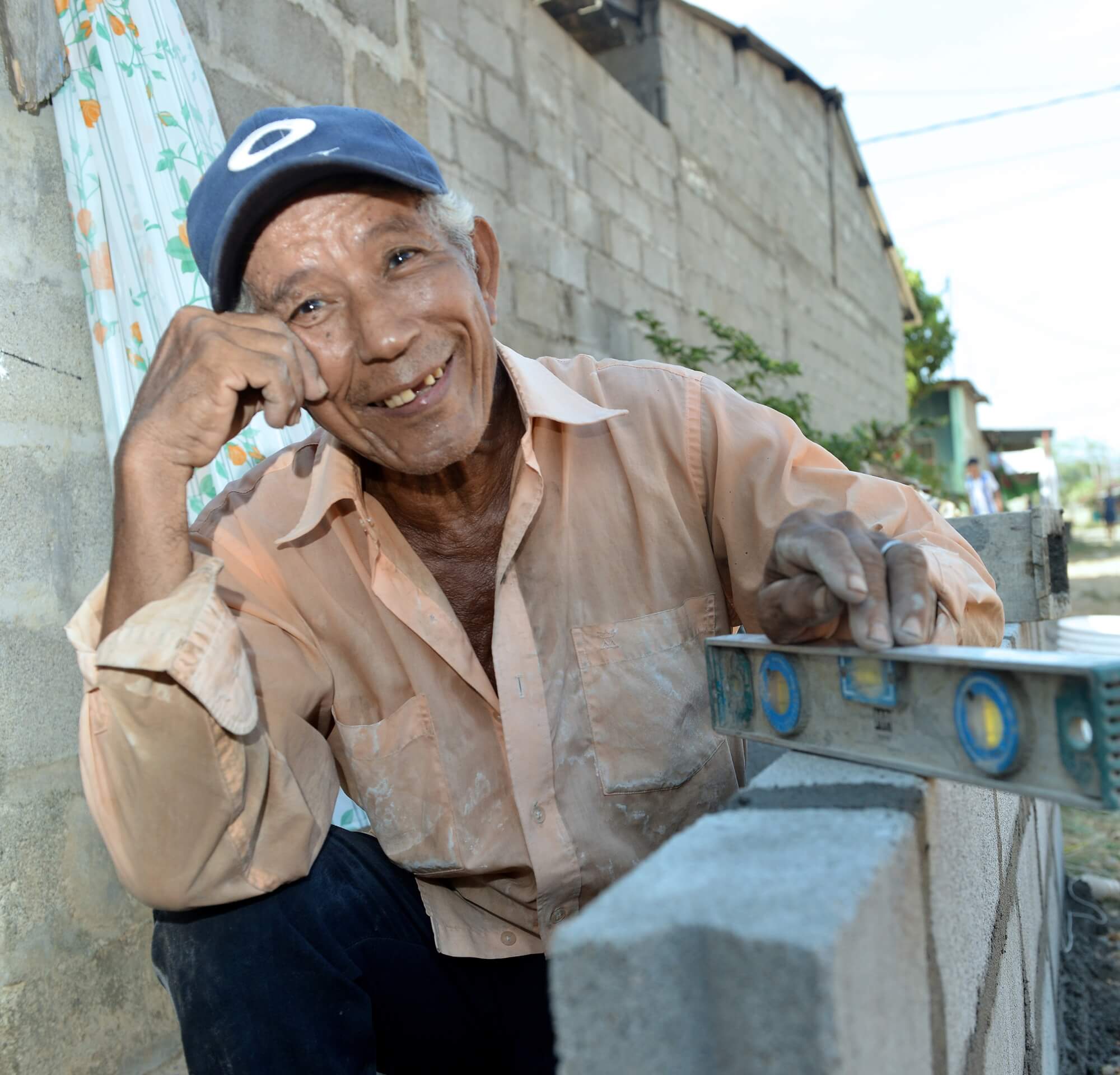
41. Public Works for Taxes is a mechanism created by the National Government in 2017, which allows companies to pay up to 50% of their income and complementary taxes via the direct execution of social impact projects in the Area Most Affected by Armed Conflict – ZOMAC, aimed at the construction, improvement, optimization, or expansion of infrastructure, and the necessary endowment for the supply of road infrastructure, drinking water and sewage systems, energy, education, and public health services, among others.
Works for Taxes 2021 Results*
| Investment line | 2021 Results |
|---|---|
| Public Services (Ecopetrol Agua y Vida and Ecopetrol Conecta) | Basic sanitation Number of People: 514 Aqueduct Number of People: 12,885 |
| Education, Sports, and Health (Ecopetrol Educa) | Education Number of Beneficiaries: 89,908 |
| Public and community infrastructure. (Ecopetrol Construye | Km of Intervened Road: 30 |
The account for a joint execution close to 60% of the total value of the investment line.
(See Graph 39 and Table 122).
Mechanisms for participation and
involvement of stakeholders in the
management of social impacts
With regard to community engagement or consultation, the most commonly used mechanisms in 2021 were in-person information and follow-up meetings, social dialogue, virtual information meetings, follow- up with authorities, and digital and/or printed newsletters.
In 2021
1,114 community participation and consultation sessions
(984 in-person and 130 virtual) were held throughout Colombia, based on current production assets (199 in total) and development projects (168 in total), thus guaranteeing a
42.2% and 49.4%
respectively, with community participation and consultation.
The main mechanisms implemented were social dialogue, in- person information processes, and community consultation (769 session out of 1,114 held – 69%).
Also, in 2021,
349
non-mandatory engagement sessions were held,
as part of Ecopetrol’s actions to build trust and strengthen the social fabric with the communities. Below is a summary of these sessions by region.
Engagement sessions
| Regional unit | Total Engagement |
|---|---|
| Sessions | |
| Central | 120 |
| Andina Transporte | 116 |
| South | 44 |
| Piedemonte | 18 |
| Caribbean | 21 |
| Orinoquía | 12 |
| East | 11 |
| Catatumbo-Arauca | 7 |
| Total | 349 |
The Company established contact with 41,603 people, as a result of these sessions. The community remained the main focus of engagement.
In the same way that Ecopetrol recognizes and respects diversity, it also interacts with ethnic groups in search for a constructive relationship. It stays attentive to the dynamics and processes between these communities, their organizations, and the State. In this sense, the Company has implemented internal guidelines and procedures for engaging with ethnic communities, for conducting prior consultations, and for dealing with situations of economic or physical resettlement, in compliance with Colombian legislation and the highest international standards, as further explained in the section on Human Rights.
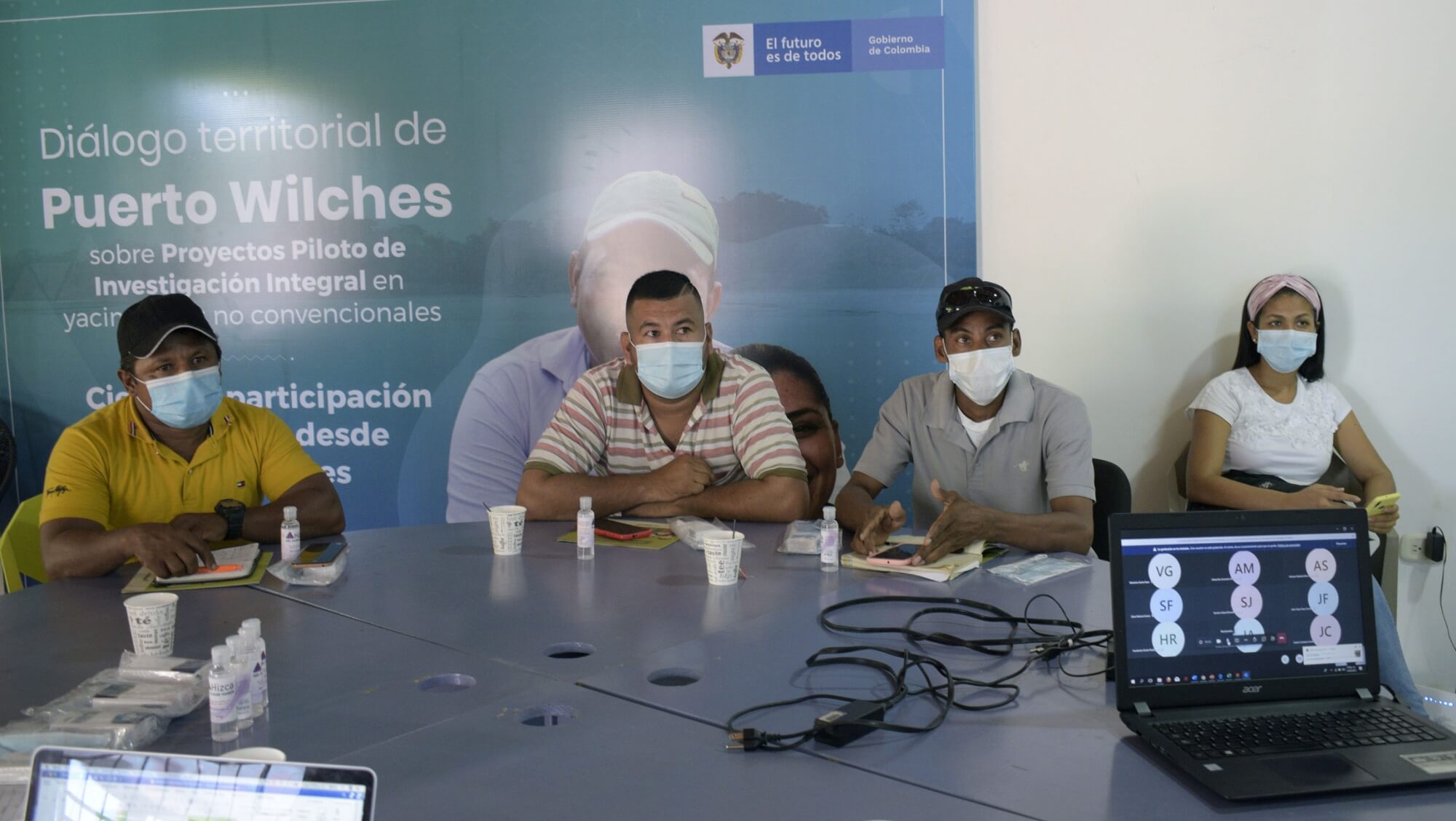

(413-2) (WEF 28E)
All operations and projects undertaken by Ecopetrol must adhere to the regulations and legal requirements established by environmental authorities, such as the MADS, the ANLA, and the CARs. By means of these instruments, Ecopetrol ensures the identification and assessment of social impacts and the definition of prevention, mitigation, control, and/or compensation measures.
Extensive and sufficient opportunities for citizen participation are created for the identification of impacts, by establishing a respectful, representative, two-way relationship, with transparent access to information, adapted to the language and cultural development of each case.
The institutional framework was articulated at all levels for the management of impacts, from local governments to national entities, also involving different associations, industry representatives, community guarantors, and the State, in order to ensure due process in the management of conflict. Conflicts in 2021 were triggered by higher expectations in the hiring of local labor and the acquisition of goods and services by the communities nearby the projects and the operation.
The impacts identified and the management measures adopted are as follows:
Impacts and management measures
| Regions in Colombia | Operations | Identified impact | Management measures |
|---|---|---|---|
| East | Production of the Rubiales and Caño Sur fields in the municipality of Puerto Gaitán, Department of Meta |
|
|
| South | Upstream: Acae- San Miguel (Puerto Colón), Arrayán, Balcón, Brisas, Cebu, Churuyaco, CPI – Dina Tertiario, Dina Cretaceo, Dina Norte Espino, Hormiga, La Jagua, Loma Larga, Loro, Mansoya, Orito, Palermo, Palogrande, Pijao, and Quriyana fields. Ceibas, San Antonio, San Francisco, Santa Clara, Sucio, Sucumbíos, Tello, Tempranillo, Tempranillo Norte Superior, Tenay, Yaguara, and Yurilla rivers. The operations are executed in the municipalities of Neiva, Aipe, Palermo, Tello, Villavieja, and Yaguará in the Department of Huila. Guamuez, Hormiga, Puerto Caicedo, Puerto Asís, Orito, and San Miguel valleys in the department of Putumayo, and Ipiales in the department of Nariño. |
|
|
| Piedemonte | Upstream: CCupiagua, Cupiagua Sur, Cusiana, Floreña Mirador, Pauto, Sur, and Volcanera fields, and exploratory activities in LLANOS 122. The operations are executed in the municipalities of Aguazul, Tauramena, Paz de Ariporo, Hato Corozal, and Yopal, in the department of Casanare. |
|
|
| Central | Upstream: Abarco, Teca-Cocorna, Aullador, Bonanza, Casabe, Casabe Sur, Colorado, Cristalina, Flamencos, Garzas, Girasol, Infantas, Jazmin, La Cira, Lisama, Llanito, Moriche, Nare Sur, Nutria, Peñas Blancas, Provincia, San Roque, Tesoro, Tisquirama, Underriver, and Yarigui-Cantagallo fields. Delineation wells for exploration activities in Flamencos, Nfe in Tisquirama – San Roque, seismic in Valle Medio, and Comprehensive Research Pilot Projects in Non- conventional Hydrocarbon Reservoirs. The operations are executed in the municipalities of Barrancabermeja, Puerto Wilches, Sabana de Torres, San Vicente de Chucurí, Rionegro in the department of Santander, Puerto Nare, Puerto Triunfo, and Yondó in the department of Antioquia, Cantagallo in the department of Bolívar, Puerto Boyacá in the department of Boyacá, and San Martín in the department of Cesar. |
|
|
| Andina | Direct operation in the MEDINA OCCIDENTAL Exploratory Drilling Area, FARALLONES prospect. The operations are executed in the municipalities of Ubalá, Medina, Paratebueno, Guaduas, Caparrapí, Puerto Salgar in the department of Cundinamarca, Suarez, San Luis, Cunday, Carmen de Apicalá, Espinal in the department of Tolima, and Santamaría in the department of Boyacá |
|
|
| Orinoquía | Upstream: Akacias, Apiay, Apiay Este, Austral, Castilla, Castilla Este, Castilla Norte, Chichemene, Chichemen SW, Gavan, Guatiquia, La Reforma, Libertad, Libertad Norte, Pompeya, Saurio, Suria, Suria Sur, Tanane, and Lorito fields, and exploratory activity in the Tejón well. The operations are executed in the municipalities of Villavicencio, Akacías, Guamal, Castilla La Nueva, Cubarral, San Martín de los Llanos, Puerto Lleras, San Carlos de Guaroa, and Puerto López in the department of Meta. |
|
|
Issues and concerns raised via the
participation of stakeholders
Ecopetrol has a variety of mechanisms and channels to properly receive and manage petitions, complaints, claims, and requests from stakeholders. Detailed information on these mechanisms and their operation can be found on page 65 of this report.
(103-3) (413-1)
Addressing requests, complaints, claims, and suggestions (PQRS) in a timely manner, and sending out congratulations, are a key pillar for engaging with our stakeholders. To ensure timeliness and relevance, Ecopetrol adopts a formal process and technological tools to respond to PQRS in an agile and timely manner, depending on the issue.
For 2021, the timely citizen response indicator stood at
99.99%.
Timely citizen response indicator by stakeholder – 2021
| Stakeholders | General indicator |
|---|---|
| Shareholders | 100.00% |
| Clients | 100.00% |
| Employees, pensioners and beneficiaries | 99.98% |
| State | 100.00% |
| Suppliers, contractors, and their workers | 99.91% |
| Society and community | 100.00% |
| Associates and Partners | 100.00% |
| Total | 99.99% |

Incidents caused
by third parties
To prevent incidents caused by third parties, which are beyond the management of internal incidents, Ecopetrol has an Enabling Plan. The plan serves to implement a preventive physical security model that gradually incorporates more technology and better training, supported by better partnerships. All of the above, in compliance with the guiding principle of Ecopetrol’s Declaration of Culture: Life First.
Incidents caused
by third parties
Three (3) attacks on the Company’s infrastructure were recorded in 2021; all three (3) attributed to illegal groups in Middle Magdalena, in the municipality of Barrancabermeja, Department of Santander (Colombia).
CENIT
Volume of spilled barrels. 275 events were recorded in 2021, with 17,609 barrels spilled. However, considering that
93%
of the events were caused by third parties,
it is not possible to accurately quantify product loss. As of December 31, 2021, the volume spilled on soil or into water bodies for 61 environmental events is yet to be confirmed.
In 2021, the incidents caused by third parties reported by Cenit affected a total of 161,770m2 (0.016177 Hade soils) and 35,715 linear meters (watercourses edges) due to containment losses,
of which 17,125 m,
were recovered, of which
42,093m2
were recovered (0.0042093 Ha).
Roadmap
Local Development
Elemento
material Excepcional
Sustainable Development Goals





| Impacted stakeholders | Areas responsible for managing the impacts | Ecopetrol segments with the greatest impact |
|---|---|---|
| Society and Community | VAB | Upstream |
| Investors and Shareholders | VDS | Midstream |
| Local State | VDP | Downstream |
| Society and Communities | VRP | |
| VEX |
Why is the
element material?
Local Development is a material element of an exceptional nature at Ecopetrol. That is, the Company seeks to become a best practice and to be recognized in the world for its efforts by generating its own knowledge and technology to enable development in its areas of influence. This translates into Ecopetrol’s commitment to improve the quality of life in the prioritized areas, consolidating high levels of trust in its communities of influence by means of three (3) objectives:
1
Closing socioeconomic gaps.
2
Reducing the factors of social conflict.
3
Obtaining social license in terms of levels of trust and identification.
Adapting and improving the conditions in the surroundings is essential to increase the Group’s operational execution capacity, achieve excellent levels of environmental performance in all Company processes, and become an agent of positive transformation by attracting partnerships, resources, and generating sustainable development in its areas of influence.
This is considered a material element due to its potential to generate value, the relevance for stakeholders, and its alignment with Ecopetrol’s Declaration of Culture.
How is the material
element managed?
The purpose of the Community Engagement Strategy is to magnify Ecopetrol Group’s value while supporting the creation of sustainable development in its areas of operation. It also seeks to build relationships of trust with stakeholders as a basis for creating mutual and lasting benefits.
Ecopetrol has adhered to the United Nations Global Compact since 2009.
For this purpose, Ecopetrol uses the SDGs as a framework, in adherence to the United Nations Global Compact initiative.
The Strategy is based on three (3) pillars:
(i)
Social investment,
(ii)
Engagement
(iii)
Physical security
Social investment, in accordance with corporate Bylaws, allows contributions to manage the surroundings of the various Company projects and operations, while contributing to the generation of sustainable development in Ecopetrol’s areas of interest or in regions around the country where said contributions are aligned with the corporate strategy.
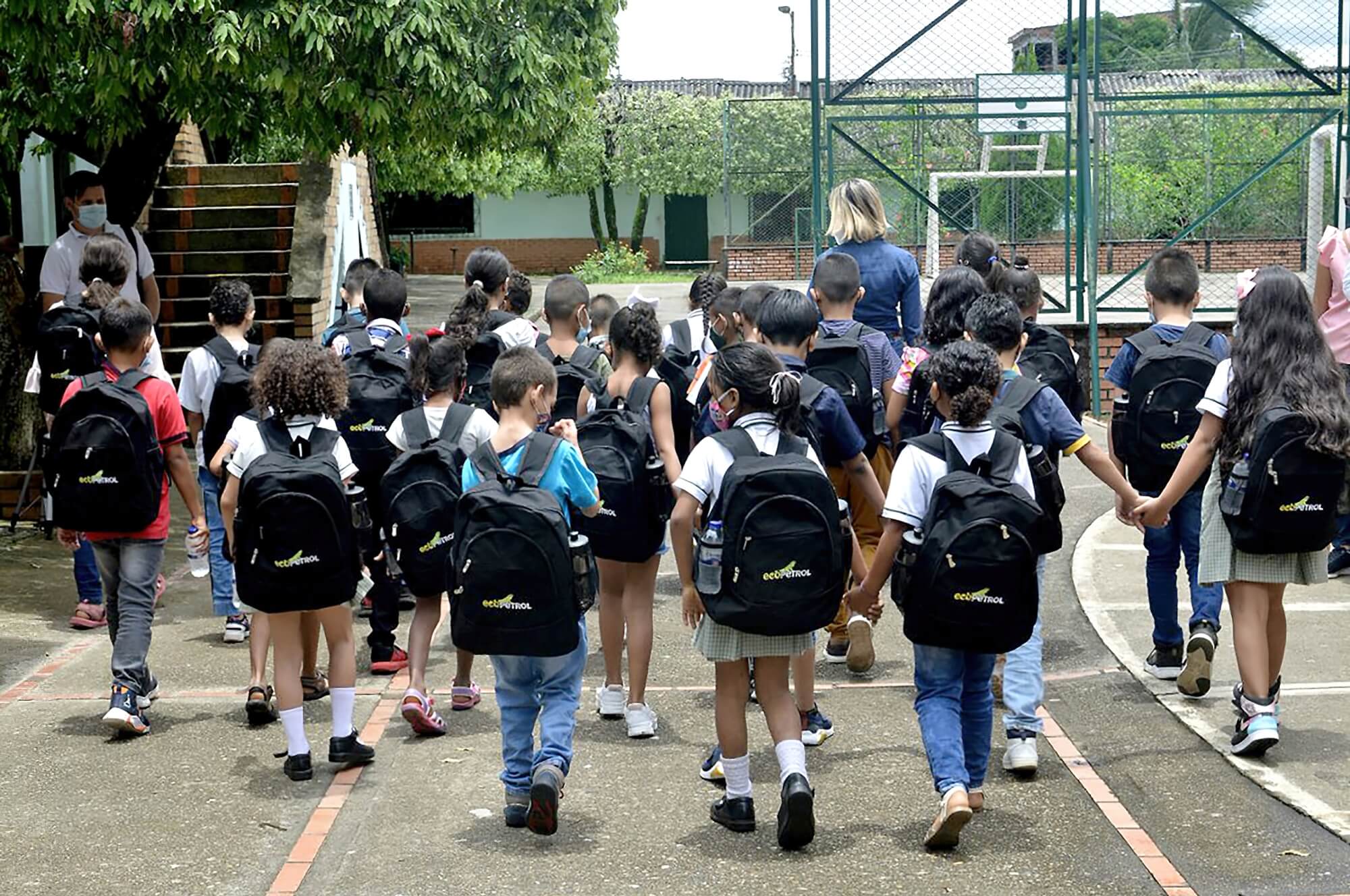
How is the material
element evaluated?
The material element is evaluated by monitoring the goals for 2024, 2030, and 2040, based on the objectives and strategic options proposed.
These results are monitored monthly using the social investment indicator that is part of the Vice Presidency of Sustainable Development’s TBG, which is monitored through the Department of Business Performance of the Vice Presidency of Finance, and whose fulfillment directly impacts variable compensation.
Short, medium, and long-term
goals and projects
Goals and projects are defined by three (3) objectives.
2024
1 Closing socioeconomic gaps
To materialize this objective, Ecopetrol has defined goals for 2024, 2030, and 2040 in three (3) strategic options
(i) Revitalization of local economies
- 25,000 jobs generated by executing the voluntary social investment
- Linking 4,475 peasant families to
- production chains
- 5,878 young entrepreneurs and 1,219 micro, small, and medium enterprises (MSMEs) strengthened
- 958 Km of tertiary roads intervened
(i) Education promotion
- 626,333 students benefited
(iii) Access to Public Services
- 1,329,704 inhabitants with access or improved access to drinking water
- 34,448 users with access to fuel gas through grids
2 Reducing the factors of social conflict
Goals in the short and medium term
- Strengthen the engagement model and preventive and inclusive dialogue
- Strengthen the citizen participation model by implementing Eco Zones
Short-term goals:
- National baseline definition of the level of social license using the Thomson & Botiller methodology in the regions prioritized by Ecopetrol.
- Define the methodology and baseline to contribute to the SDGs.
2030
1 Closing socioeconomic gaps
To materialize this objective, Ecopetrol has defined goals for 2024, 2030, and 2040 in three (3) strategic options
(i) Revitalization of local economies
- 105,000 jobs generated by executing voluntary social investments
- Linking 9,000 small-producer families to production chains
- 13,500 young entrepreneurs and MSMEs strengthened
- 1,800 Km of tertiary roads intervened
(ii) Education promotion
- 1,252,000 students benefited
(iii) Access to Public Services
- 1,900,000 inhabitants with access or improved access to drinking water
- 75,000 users with access to fuel gas through grids
2 Reducing the factors of social conflict
Goals in the short and medium term
- Strengthen the engagement model and preventive and inclusive dialogue
- Strengthen the citizen participation model by implementing Eco Zones
Medium-term (2030) goal:
- Percentage increase in national confidence level
2040
(i) Revitalization of local economies
- 230,000 jobs generated by executing the voluntary social investment
- Linking 18,000 small-producer families to production chains
- 25,000 young entrepreneurs and MSMEs strengthened
- 3,000 Km of tertiary roads intervened
(ii) Education promotion
- +2,000,000 students benefited
(ii) Access to Public Services
- 2,400,000 inhabitants with access or improved access to drinking water
- 150,000 users with access to fuel gas through grids
2021
Management Efforts
The revitalization of local economies includes the efforts made for economic reactivation after the pandemic, involving nearly
1,100
small producer families
in rural development programs and more than
450
entrepreneurs and MSMEs
under the Ecopetrol Emprende program, in order to boost income generation.
Local employment generation through the intervention of
62 Km of roads,
with works beginning in an additional 238 Km.
There are also
19 of tertiary roads,
underway for the improvement of
236 km of tertiary roads,
mainly in Meta, Casanare, Santander, Cundinamarca, and Huila, directly executed by Ecopetrol.
In terms of education promotion, the Company benefited
more than 190,000 students
with pedagogical models, teacher training, material for students returning to school, higher education scholarships, and the improvement of educational infrastructure.
The Society and Community stakeholder is Ecopetrol’s partner in the execution of its corporate purpose. Efforts were made in 2021 to ensure compliance with the value proposal and to maintain a relationship based on trust and transparency
(201-1) (WEF 18) (WEF 21) (WEF 32E)
The economic value in voluntary investments in the community amounted to
COP 199,056,832,849,
in 2021, with a
3%
decrease compared to 2020, due to the achievement of capital efficiencies in the execution of resources to support the COVID-19 emergency.
Investment category
| Investment category | COP | % of total social investment |
|---|---|---|
| Assignments without cost | 374,416,824 | 0.18 |
| Voluntary social and engagement investment | 199,056,832,849 | 99.73 |
| Sponsorships related to social causes and promotion of the Ecopetrol brand | 156,922,975 | 0.08 |
| Total | 199,588,172,648 | 100 |
Type of contributio43
| Type of contribution | Unit of measurement | 2021 |
|---|---|---|
| Voluntary social and engagement investment + Sponsorships related to social causes and the promotion of the Ecopetrol brand | COP | 199,213,755,824 |
| Cost-free transfer of assets | COP | 374,416,824 |
| Operating costs | COP | 77,705,310,939 |
43. The units in which the figures were reported in the version of this report for the right of inspection were adjusted.
In the strategic option “Access to Public Services,”
more than 21,000
inhabitants benefited
from access to water in the municipalities of Cúcuta, Barrancabermeja, Villavicencio, Guamal, and surrounding villages.
The necessary activities were similarly conducted through Ecopetrol Conecta to connect
6,132
families in rural communities
in the departments of Arauca, Casanare, Antioquia, Santander, and Meta, benefitting
10,691 families
with Ecopetrol’s Social Gas Program (via agreements) since 2019.

